#Convergence of contrasting views
Text
Exploring the Paradox: The Convergence of Heaven and Nihilism
In a seemingly paradoxical twist, the concepts of heaven and nihilism intersect at the edges of human understanding, offering contrasting perspectives on the nature of meaning and perfection. While heaven is often associated with ultimate fulfillment and perfection, nihilism challenges the inherent meaning of existence. In this thought-provoking blog post, we will delve into the intriguing convergence of heaven and nihilism, exploring how these seemingly opposing viewpoints shed light on our quest for meaning.
Heaven as the Culmination of Meaning: Heaven, often portrayed as a realm of perfection and ultimate fulfillment, represents the pinnacle of human aspirations for a meaningful existence. It embodies the ideal state of being, where all desires are met, and harmony prevails. From this perspective, heaven is viewed as the endpoint of the search for meaning, encompassing abundance and fulfillment in every aspect of existence.
Nihilism: The Perfection of Nothingness: In contrast, nihilism challenges the very notion of inherent meaning and purpose. It posits that life is devoid of objective significance, highlighting the absence of inherent value and purpose in the universe. From a nihilistic perspective, perfection lies not in abundance, but rather in the recognition of nothingness as the ultimate truth. Nihilism embraces the idea that in the absence of imposed meaning, one is free to define their own sense of perfection.
The Paradox of Perfect Nothingness: The convergence of heaven and nihilism reveals a paradoxical perspective on the nature of perfection. While heaven embodies perfection through abundance and fulfillment, nihilism perceives perfection as the acceptance and embrace of nothingness. This paradox challenges our conventional understanding of perfection, inviting us to contemplate alternative interpretations of meaning and fulfillment.
Meaning in Imperfection: A deeper exploration of the convergence of heaven and nihilism prompts us to question whether perfection is inherently tied to meaning. Nihilism invites us to find beauty and significance even within the imperfections and limitations of existence. It challenges us to seek meaning not in an idealized state of perfection but in the acceptance and embrace of our flawed and finite nature.
Embracing the Journey: Rather than perceiving heaven and nihilism as irreconcilable opposites, we can view them as complementary aspects of the human experience. Heaven represents the longing for transcendence and the pursuit of ultimate meaning, while nihilism reminds us of the importance of questioning and critically examining established meanings. Both perspectives contribute to our ongoing journey of personal and collective discovery.
The convergence of heaven and nihilism challenges our preconceived notions of meaning and perfection. While heaven embodies the quest for abundance and fulfillment, nihilism questions the inherent meaning in existence. By exploring their convergence, we open ourselves to a richer understanding of the complexities of the human experience and the diverse interpretations of meaning. In this exploration, we find room to contemplate the significance of imperfection, the power of individual interpretation, and the ongoing search for personal fulfillment in the face of existential uncertainty.
In embracing the paradoxical nature of heaven and nihilism, we embark on a profound philosophical journey, questioning traditional assumptions and exploring the intricacies of human existence. As we navigate this intellectual exploration, we gain insights into the diverse perspectives on meaning, purpose, and perfection, ultimately enhancing our understanding of the intricate tapestry of the human experience.
#philosophy#ontology#epistemology#metaphysics#knowledge#learning#education#chatgpt#Heaven and nihilism#Meaning and perfection#Paradoxical perspectives#Quest for fulfillment#Exploring existential uncertainty#Philosophy of meaning#Embracing imperfection#Convergence of contrasting views#Human quest for significance#Challenging conventional beliefs#Philosophy of existence#Search for personal fulfillment#Alternative interpretations of perfection#Questioning established meanings#Navigating the complexities of meaning#Philosophy of transcendence#Embracing nothingness#Perceptions of abundance and nothingness#Interplay of heaven and nihilism#Diverse perspectives on meaning and perfection
1 note
·
View note
Text
Virtual Photography Guide: Composition

One of the in-game activities I enjoy the most is trying to replicate real-life photography techniques in gpose, and it’s surprising how much can be achieved. So today, let’s play around with composition!
Leading Lines
Leading lines can help guide the viewer's eye through an image. They’re visual elements that form lines, like buildings or roads, or even an area with high contrast, like the horizon line. So by aligning convergent lines to create these ‘focal zones’ you build a sense of depth and lead the viewer's gaze toward it.
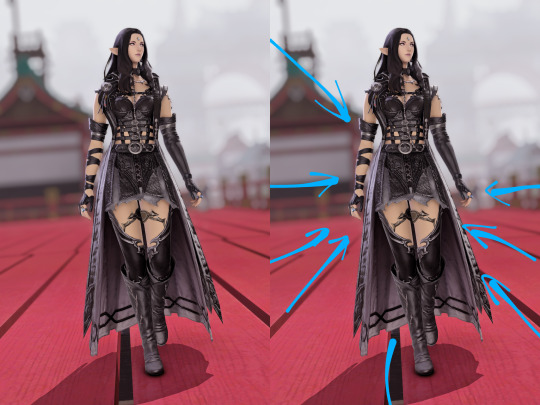

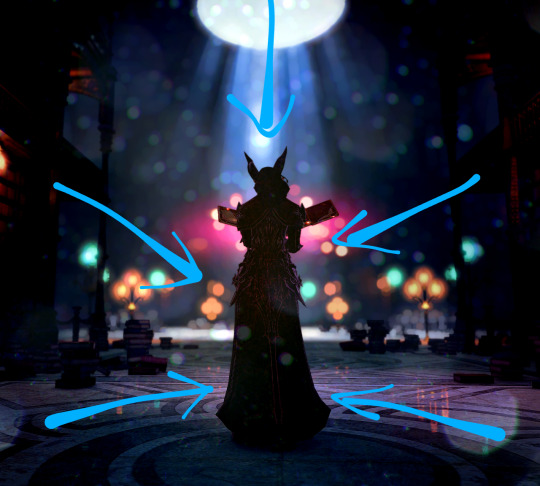

Framing
You can use elements within the scene to enclose or surround your main subject. These elements could be natural, like branches or foliage, or architectural, like doorways or windows. This adds depth and context, and helps the viewers immerse themselves in the scene:

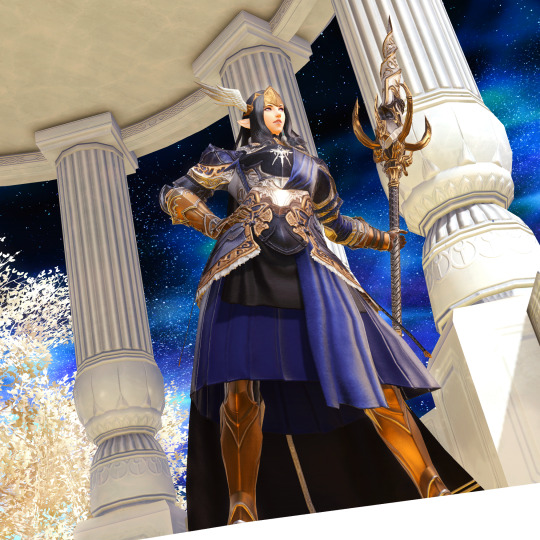
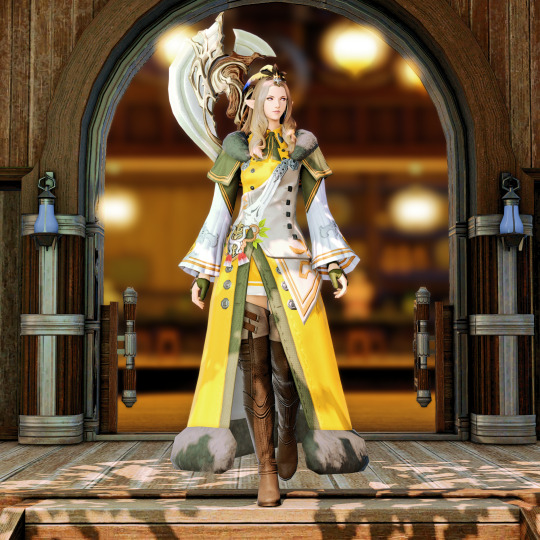
Symmetry
Symmetry creates a pleasing sense of order and balance in an image. You can do this by dividing your frame equally and positioning similar elements on either side:
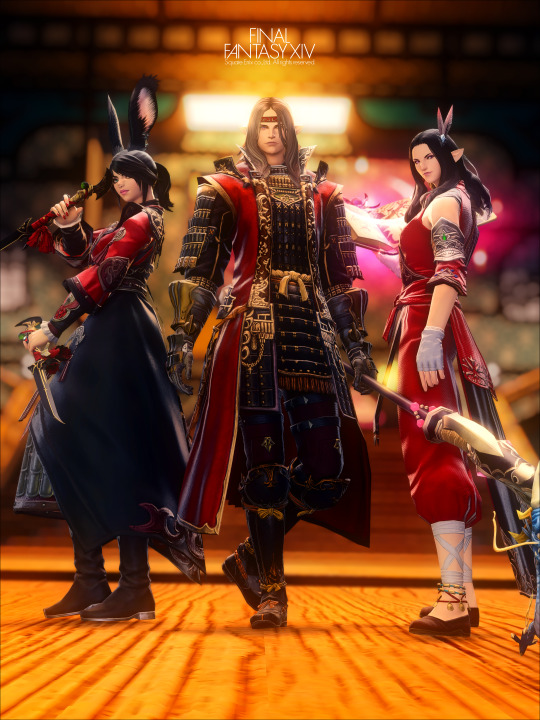


Depth and Layering
Adding depth to your virtual photographs enhances the sense of immersion. By placing objects of interest in the foreground, middle ground, and background, you can create a layered effect that adds depth and dimension to your composition. DoF (Depth of Field) shaders are particularly well suited for cases like these:
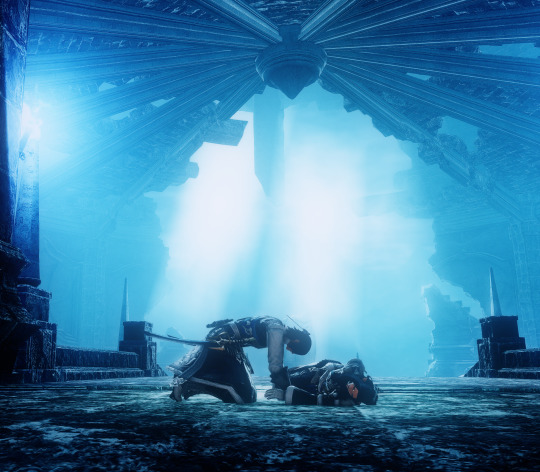


Point of View
Experimenting with different and unusual camera angles and perspectives can yield surprisingly dynamic and engaging shots. For example, positioning the camera at a low angle and looking up at the character can create a very impactful composition:
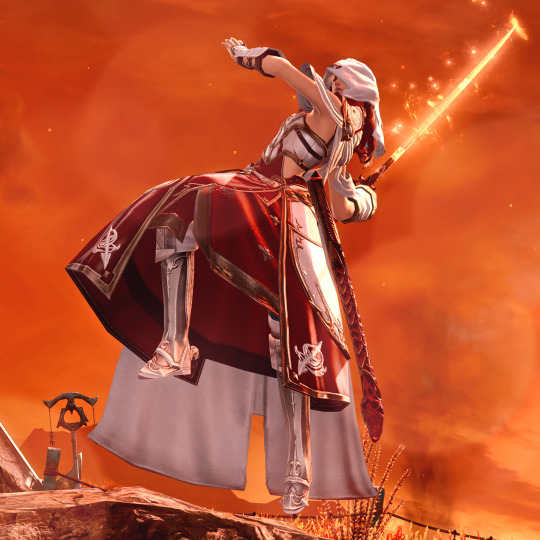


On the other hand, top-down pictures can not only give the viewer a sensation of being ‘in the scene’ but also help put elements together that would otherwise be scattered around in a horizontal shot:


Negative Space
Negative space refers to the empty or minimalistic areas in your composition. It provides breathing room for your main subject and can evoke emotions, or create a sense of balance and calmness.


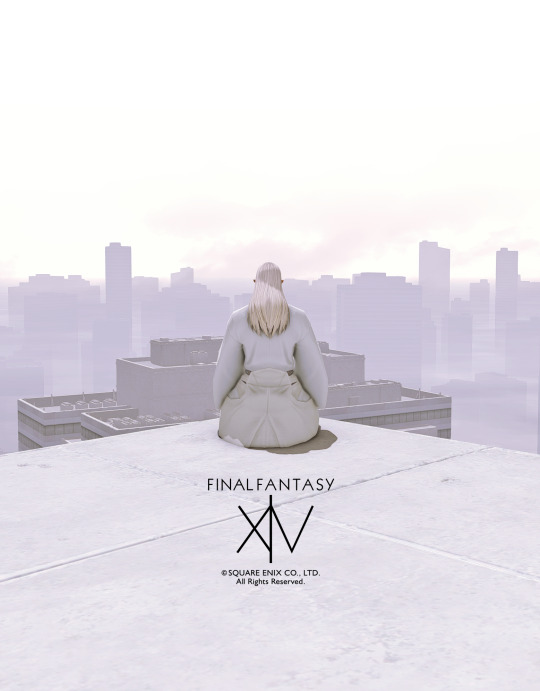
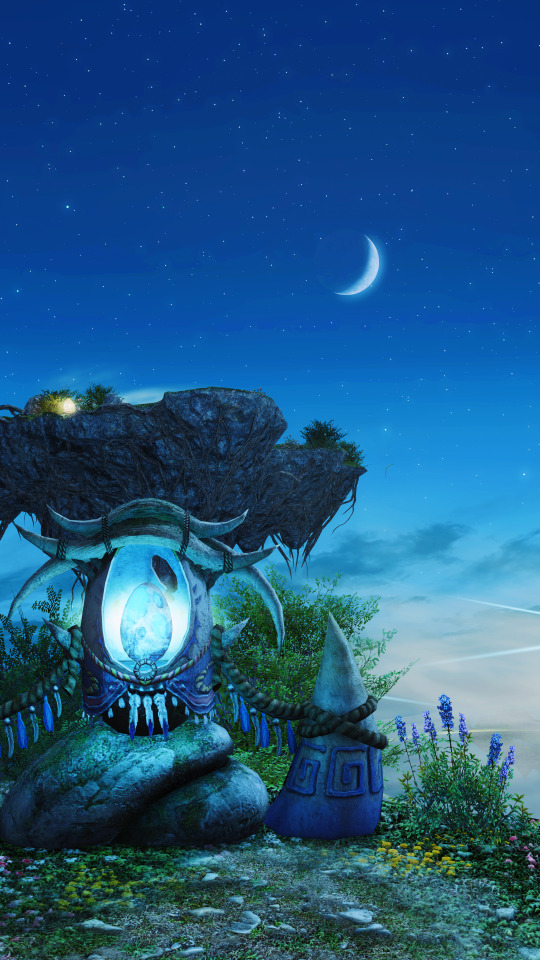
And let’s not forget the most important rule of all:
Break the rules
These principles serve more as guidelines than anything. Sometimes trying to force a composition into one of those categories can detract from an unusual yet powerful shot, so trust your eye and aesthetic sense.
I'll cover more composition techniques like the Rule of Thirds, Rule of Odds, Rule of Space, Golden Ratio, and others in part 2. Enjoy!
583 notes
·
View notes
Note
Got a Worm meta question for you. I'm starting on the early parts of Taylor's warlord era - I'm about to leap into Arc 13 - and the general concept of a ravaged American city being divided up by various supervillain groups is reminding me a lot of that Batman story arc No Man's Land from the late 1990s. Unfortunately my comics knowledge is rudimentary at best, and I haven't been able to any discussion comparing the two stories, so I was wondering if I could pick your brain on the subject. Was it just convergent evolution, or was Wildbow engaging with the Batman story in some way?
I myself have only read about half of No Man's Land- and several years ago to boot- so I've got limited ability to do a direct compare and contrast. No Man's Land is absolutely the sort of status-quo-shattering, history-book-making upset that, within Marvel and DC, nonetheless always inexplicably heals and loses salience until you can barely tell that it's still in continuity. Worm is heavily informed by Wildbow's irritation with that sort of thing, so I think it's totally reasonable to view the warlord era through the lens of "What if No Mans Land had no editorial escape hatch." Alternatively, I think it kind of makes sense to view it through the lens that it's working backwards from the premise of No Man's Land- In what kind of setting would it be plausible for the Federal Government to write off a sufficiently-damaged American City? In what context would the legal infrastructure have been established for that, in what context would that even fall within the Overton Window?
What muddies my opinion on this is that the general concept of a ravaged, atmospherically-apocalyptic American city torn up by superpowered gang warfare is something that's kind of just been in the water in superhero comics since the mid-eighties at least, and it was a relatively common thing to see during the Dark Age- they were choice prey for all those overpouched musclemen with their poorly rendered firearms. I'd be surprised if Wildbow wasn't at least aware of No Man's Land, but it's definitely not the only cape book from the late 90s or early oughts where you could pick up that idea from. Ultimately this leaves me unsure if No Man's Land is the specific referent or if it's just part-and-parcel with trying to do an involved, thoughtful take on what cape comics were like at the time.
#I think there are ways in which this whole thing plays into urban hellscape narratives about cities in the 90s#which I don't feel totally equipped to pull apart atm#one indie cape setting which played this angle that stuck in my head was that aborted pilot project for a shared cape setting Dark Horse di#But I recall a distinctly apocalyptic vibe to a lot of the stuff I used to read from back then#thoughts#wildbow#parahumans#ask#asks#wormblr#worm is more and more a period piece for cape comics in the early oughts specifically with each passing year#sorry for the delay in responding
95 notes
·
View notes
Note
☕️ trans girl verity :33
Verity as a trans girl is one of those headcanons where for me, it really makes the text as we are given it more coherent. It provides a lot of implicit motivation for things the comics kind of don't bother exploring her feelings about, I think. We have all that stuff in the early phase one stuff where she is nebulously "troubled" and constantly running away, happier to live as a young teen on the streets despite obviously knowing the risks inherent to that. There's her extremely glossed over (and very deftly executed so the reader doesn't question it) decision to leave Earth entirely to go hang out with Ultra Magnus. There's her reluctance to go back to a mother she was taken away from because doing so is scary, even if she now can.
And it's hardly as though "the foster care system Fucking Sucks" etc is not adequate for explaining that, to be clear, but I feel like Verity feeling invested in staying in this new world where everything is incredibly dangerous but also where she meets all these people with no context for who she might be in the "real world", who she gets to take control of how she presents herself to them... that's a narrative that works really well for exploring through a trans lens. What her association with these people offers her, despite the danger, despite all the traumatic experiences, despite how clearly negative so much of it is, boils down to a sense of agency. (And agency is really important to Verity; everything about how she acts in SotW boils down, by her own admission, to wanting that sense of control in the face of something she can't escape.) It offers her an opportunity to decide who she presents herself as to people with absolutely no way of questioning a lot of things her fellow humans might question her on, and viewing that through a lens of trans self-determination is really interesting in how it adds additional framing to that arc she gets. Sure, running off with the big scary alien robot embroiled in active warfare as a tiny squishy young human does not sound like a great idea- but if the tradeoff is that you can really truly reinvent yourself and nobody even knows that they could question it, well. Especially in contrast to how it makes her ostensibly 'peaceful' life she could otherwise return to in fact one that isn't uncomplicatedly peaceful at all as someone facing very different kinds of fear in that "normal" life.
There's also the fact that as you move through SotW and RotW, her arc converges with Springer's about what self-determination looks like. Springer's arc in the latter two-thirds of Wreckers is about making active choices to decide who you want to be in the face of cycles that try and force you into being a specific person you find that you do not like very much. People have a very specific idea of who you were supposed to be for them; resisting that because you do not want to is hard. Choosing something else is hard. That has a lot of resonance for a Verity who had to make that decision because she is trans, I think, at an exaggerated scale.
And the great thing is: it works. Verity gets to choose, as an adult, to meet her mother again on her own terms. She conquers all her nightmares and gets through it and reenters the world as an adult woman who is confident enough to assert herself and take what she wants. She can go back into that human world and assert who she has chosen to be there in a way she couldn't before. It works that way with or without the trans element, but the trans element just fits in smoothly, I think. It really adds to my love for her character to think of it as a part of that story about developing a sense of self.
44 notes
·
View notes
Text
Madoka 1.5
Since I’m watching PMMM for the first time (with a lot of it spoiled due socmed lol), I figured it’d be fun to write my thoughts so far, 1.5 episodes in. It goes without saying, but don't send me any further spoilers, as this is only fun if I can manage to remain as ignorant as I am now.
Things I knew before hand:
-Kyubey is a bastard.
-It has Shinbo Akiyuki's artistic sensibilities all over it (reason I started watching, tho I'm unclear what exactly his involvement in this is lol). Also, Urobuchi Gen is the main writer for this lol
-Madoka dies.
-Madoka is the paragon of good.
-Lesbian Satan.
-Homura has catholic guilt??
-Someone's backstory involves a brother or something.
-Guns
-Time loop.
-Jewel seeds but evil (this only makes sense if you've watched Nanoha, sorry lol)
-Witches
-Madoka saved a cat
---
--
-
¯\_(ツ)_/¯
Illusory motion.

[image id: top view of a monochromatic, distorted staircase that looks like a spiral.]
An upwards climb or a downward spiral? The irregular curving of the stories and the pattern alternance sure makes it look like it's spiraling inward. As our lace curtain lifts so the play can begin, this is our first look at the kind of world that awaits us.

[image id: gif showing a close up to Madoka's legs and then a panoramic top view as she runs through a monochromatic hallway with a chessboard pattern]
I don’t have a lot to say about the witches’ labyrinths yet, but I’m always a sucker for dreamscapes (I loved them dearly in Flip Flappers, where they had the incredible work of Studio Pablo strengthening the storybook look), and I’m assuming the labyrinths symbolize something about the interiority or the difficulties the witch in question faced. I don’t have a lot to go by with the two labyrinths in episode one, but I did love the glimpse of the one we get in the opening sequence. I love the effect that it creates when alternating between panoramic shots or extreme close-ups to Madoka’s legs and back as she runs—respectively making her look too small against this overwhelming set piece or claustrophobically trapped in her impotence. As the camera moves along, there’s a sensation that the different patterns in the floors are moving. Because of the way we perceive depth via ascertaining the apparent parallelism or convergence of lines and value/color contrast, among other things, the pattern alternance in this monochrome set piece creates illusions of either motion or that each row is a step more elevated than the other. It’s a properly trippy place. I enjoy it. The straight white for the lighting and tiles creates an artificial and alienating atmosphere. The uniformity of its looks is disorienting. Is Madoka going the right way? It’s really a fantastic introduction to the world of Madoka Magica.
The path you must follow has been prepared for you.
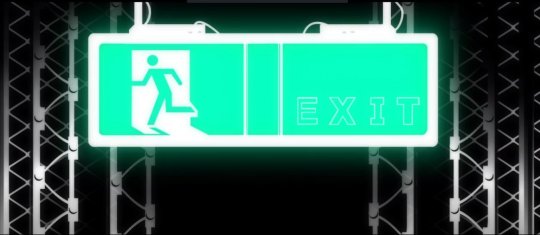
[image id: A green, flourescent exit sign is centered in the screen, hanging above a dark path framed by silver chain fence]
Despite the disorienting feeling, Madoka follows mostly straight paths and there's a clearly labeled, correct exit. This brings to mind the predetermined paths present in Revolutionary Girl Utena's imagery.
Additionally, I find the way Madoka’s run is boarded reminiscent to Utena’s chase after Anthy in Adolescence of Utena:
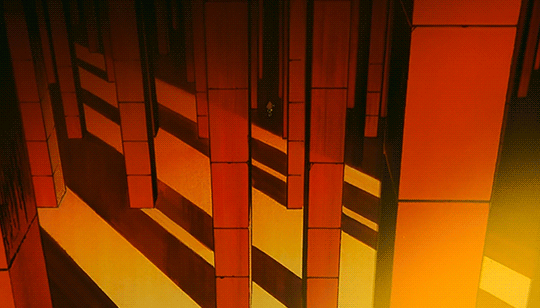
[image id: gif showing a panoramic view of of landscape shwoered in sunset lighting and red, square pillars towering over the space. Utena, looking tiny, runs further into the place.]

[Image id: gif showing a top down view of a long monochromatic corridor with chessboard pattern that Madoka, a mere pink dot in the screen, crosses running. The corridor is right in the middle of the screen and surrounded by different equally black and white mandalas that turn slightly.]
We get panoramic overhead shots emphasizing the disorienting, geometrical maze and the impotence of our heroines' tiny figure against them.
Before reaching their destination, they both cross a stairs-bridges of sorts; Utena, towards the dueling arena where Anthy waits for her to continue the dueling cycle with Utena as champion; Madoka, towards the foyer where she can find her exit to where Homura is struggling against another hopeless, fighting cycle, one which Madoka choses to perpetuate when making a contract with Kyubey…
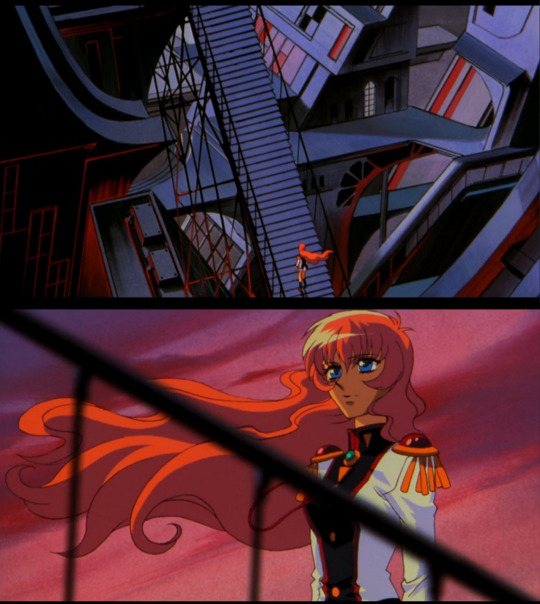
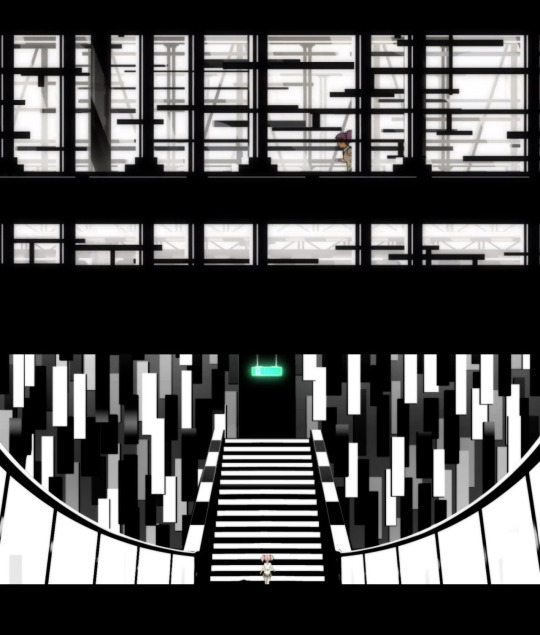
[Image ids:
The image to the left shows shows a stich of two Adolescence of Utena's screenshots: the one on top showing Utena crossing a bridge; due the top down angle and the inclination of the bridge, the planks on the bridge look like stairwells. The image on the bottom shows Utena crossing the bridge against the creamy, pinkish sunset sky. The bridge railing is shown a black silhoutte in the foreground.
The image to the right is a stich of two monocrohmatic Madoka Magika episode one screenshots: the on the the top shows Madoka crossing a corridor, the foreground is dominated by abstract geometric shapes. The one on the bottom shows Madoka going up an ample stair well, and the surrounding walls have a similar geometric patterning.]
Absolute Reality.
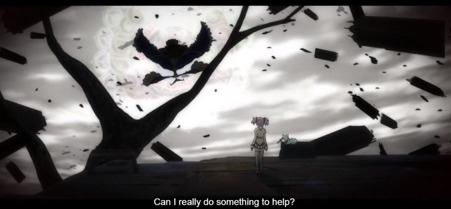
[Image id: Predominantly black and white screenshot showing a dark tree on the foreground and black debri flyaing around. A little to the right of the middle line stands Madoka, with Kyubey sitting on top of some fallen pillar. The subtittles are Madoka's dialogue and read: "Can I really do something to help?"]
The offer that tempts Madoka into a contract is the promise of agency. She can’t stand the reality where there is nothing she can do, thus it's the promise she does actually have power to influence the narrative and help others and stop their suffering what Kyubey dangles in front of her. Madoka feels deeply moved by the pain of others and has a strong empathetic response that makes it very easy for her to be preyed upon by our resident ugly cat here. It’s detrimental to her. Maybe Homura has a point in reversing her wish to be the divine embodiment of Goodness.
It’s then interesting that she expresses disappointment upon waking up not only in the premiere but in episode 02, as well. Her waking up animation might as well become bank during this introductory arc (I’m betting it does, can’t wait to be wrong). When confronted with the thought the world her senpai Mami introduced to her, one of great danger but also apparently fulfilling and actualizing, Madoka expresses disappointment. Even though she has a happy, easygoing life full of friends and family that love her and that she loves in return, there is something else she is looking for.
Confronting your own humble plainness again.

[Image id: Screenshot of Madoka's room dimly lit. Madoka is drawn towards the bottom left edge, hunching and hugging her huge body plush with a beleagered expression.]
Appearances, facades.
Trained confidence.

[Image id: Screenshot showing makeup labelled with numbers, as if to indicate the order of steps.]
Following Madoka’s "dream", we learn about her homelife anchored around her interactions with her mother as they talk about the love lives of the people around Madoka, contrasted to Madoka's own assertion that no one has an eye on her. Their whole bathroom conversation could be characterized as "girl talk": they go on about love and the need to maintain an appealing image as means to reach it. I could easily accuse this scene of being sexist (and it did rub me the wrong way initially), but the dialogue is naturalistic enough to paint a trusting, warm bond between mother and daughter; plus the repetition of the make-up motif in the second episode while interspersed with Mami's explanation draws attention to themes of appearance and desire.
A remark that can easily be taken as reinforcing gender essentialism lol

[Image id: Screenshot showing the sinks at the foreground barely visible at the bottom edge, with Madoka and her mother in front of them. Madoka is holding her red ribbons with her left hand hesitantly, while her mother has her hands over her hips, talkig matter-of-factly: "A woman's appearance is the one thing she can't afford to get looked down at."]
The contrast in the way mother and daughter carry themselves is apparent. When Madoka relays her reports about her homeroom teacher's love life, her more experienced mother offers keen observations about the possible state of the relationship. Where Madoka takes things at face value, her mother can see deeper. The same applies to the image they project to the world— where her mother has a set (numbered) method to achieve her ideal image, Madoka fumbles and fusses about her ribbon choice and not being seen as too much. The frame pan showcasing the end result has Madoka standing timidly with her hands folded over her lap and her back reflection shown in three different angles in the background mirrors, as if she's being thoroughly scrutinized. While her mother confidently observes her reflection in the mirror, Madoka shrinks at being observed.
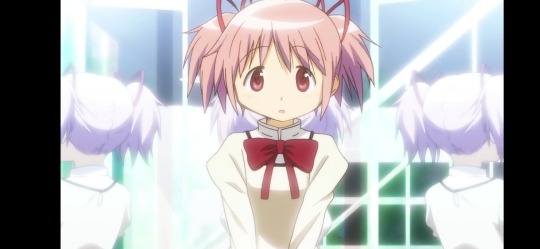
[Image id: Screenshot showing Madoka in the middle with a dopey and hesitant expression and her arms drawn close. Her reflections are shown in the mirrors in the background.]
I can't say that Madoka’s self-confidence is worryingly low given what we’ve been presented with—while she lacks the self-assurance her mother possesses, she doesn’t seem particularly self-deprecating. While her affirmation that no one looks her way reflects that self-consciousness, Madoka doesn't further put herself down. Instead, it could simply be that she's a teenager only now discovering her identity, what she's comfortable with, what she wants and what place can she carve for herself in this world. Her mother advises her to train the image and behaviors of someone confident as a first step to grow more certain of herself. The scene places emphasis on the process of purposefully building the image you project, which becomes relevant as episode two's layouts play with a reflection motif around talks of desire.
While thinking back on Kyubey’s proposal of granting them one wish in exchange of risking their lives, Madoka ponders about what she wants. Her waffling contrasts to her mother’s immediate, cutting response concerning pragmatic concerns from her work life when Madoka echoes the question to her. Although, of course, her mother lacks the whole context that makes the decision heightened, Madoka’s roof talk with Kyubey and Sayaka reinforces that there isn’t anything she wishes for that strongly. Yet.
Additionally, when Madoka proposes a bigger ambition to her mother (“Wouldn’t you rather become CEO yourself?”), the image her mother projects into the mirror changes drastically into a more fierce and dangerous look, complete with the repetition of her labeled make-up symbol. This ties a connection between the image people project and what they desire. And just like Madoka has a rather inhibited persona, so do her desires appear mild.
This takes us to Mami, their helpful senpai.
A slightly distorted image seen from below the glass table totally screams trustworthy.

[Image ID: Screenshot of Mami drawn in a low angle, showing her sitting with her legs neatly folded under her backside and her hands resting on her lap. Despite the sunset light filtering through the windows, she's very dimly lit. Most of her image, from the waist up, is shown slightly distorted as its filtered through the glass of the table. The table legs curve outwards and frame her the image in a strange way. The subtitles present her offer: "You should see for yourself what it's like to do battle with witches."]
Knowing the spoilers that Homura is trying to save Madoka from death via time loops and preventing her from forming a contract with Kyubey has an interesting effect— that is, it casts suspicion over other characters. Mami is the helpful senpai that shows up in the nick of time to save them from the witch, heals Kyubey, explains the situation to them and even promises to protect them from Homura at school. She also offers to show them the fieldwork so they can make up their mind about whether to become contracted! The earlier, careful portrayal around purposeful appearances and the reflection motif repeating during their talk can’t be coincidence. Clearly, she wants to be seen as someone who’s dependable, and whether this has more sinister implications or is stemming from personal wishes is unclear to me yet. Mami feels more like Kyubey’s sales associate than anything else. “You can come observe” it’s the pitch you give someone unsure whether to join a club so you can lure them further in. She’s encouraging them to take on a responsibility that can have rather grim outcomes, despite her early assertion that magical girls don’t necessarily work together to reap the rewards of fighting witches—a statement that further reinforces the narrative of Homura as an antagonistic force to our young heroines. Mami either is very upstanding and thinks it’s a duty they should take on since they were chosen or there is something deeply fishy going on here.
For all intents and purposes, Mami is a completely separate entity to our young heroines, not unlike Homura. She’s the one who’s a magical girl already, they’re the uninitiated. They sit on the same side of the table, opposite to her. This shot emphasizes their separation through the black leg of that foreground furniture.
There’s clearly a lot we don’t know about her.
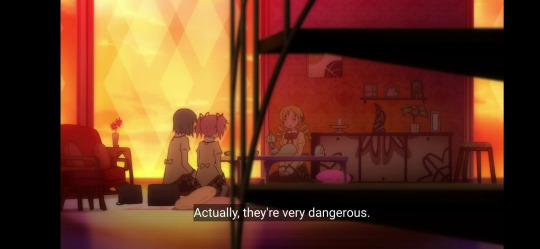
[Image id: screenshot showing Mami's living room. There's sunset light still filtering in, but the room is mostly dimly lit. Mami is on the side of the wall, so she's in the shade. They're sitting at the table, Madoka and Sayaka together on the same side and visually opposite to Mami. The black legs of a furniture are shown in the foreground, creating a strong visual barrier between Mami and her juniors.]
Isn’t it just so fun how this reflection shot obscures her face? Like she’s covering it with her hands in sorrow. Seems charged that it coincides with her explanation about witches causing suicide and murder, does she know of someone who was a victim of them? OR better yet, someone who became One?
I know that magical girls become witches in this series, which also poses interesting possibilities…

[Image id: Screenshot showing Mami's lap with her hands resting on top of it as she sits in front of the table. Because of the top angle, the reflection of her face shows dimly on the glass table. Her face overlaps her hands. The subtitles read: Many of the inexplicable suivides and murders that occur..."]
Are my suspicions on Mami’s intentions totally off-mark? I have no idea, but it’s incredibly fun to doubt her lol
Speaking of despair lore, I usually raise my eyebrow—think it’s full of shit— when there’s worldbuilding that links suicide and violence to supernatural entities; it’s a run-of-the-mill battle shonen explanation, Noragami also uses it with Ayakashi as amalgamation of negative feelings and energy from the people of the places they haunt. Now, this could still work on an allegorical sense of how oppressive environments lead to such emotional outcomes, since most stories don’t engage with the structural causes of such problems… It can be that, or end up attributing a metaphysical cause as the source of all darkness without even so much extending understanding and sympathy to the people who suffer from it. Where does Madoka Magica fall, I wonder…
Blessed fools.
A pained smile framed behind by bars, a surefire sign that someone isn’t totally trapped.
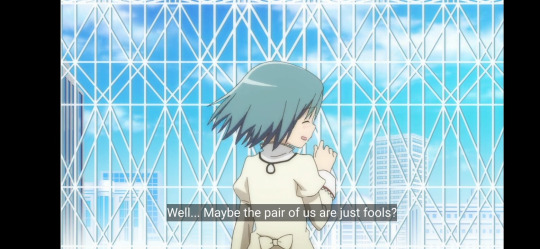
[Image ID: Screenshot showing Sakaya's back with her face turned in profile towards the right. She's smiling ambigously and her right hand is holding to the white chain wall that dominates the background against the bright daylight sky. The subtittles read: "Well... Maybe the pair of us are just fools?"]
Given our young heroines lack of direction, ardent ambitions or anguishing desires, Sayaka muses that perhaps the fact they don’t have anything they’d die for is a sign they’re blessed fools. This rings true for Madoka. She’s a happy kid with a supportive family and friends. Despite her longing for something more—her own agency? confidence? Romantic love?—, there doesn’t seem to be anything that is making her actively miserable. Her mild adolescent ennui is not necessarily something pernicious and would’ve likely resolved itself as she experienced and tackled more challenges in her life with the guidance and support of her family. This whole business paints more ill-fated for her (and I mean, I know it is. What a tragedy, hers).
But is this true for Sayaka? This brief shot with its ominous red sky and its bedridden figure shrouded in darkness begs to differ… The fact she feels guilty over being chosen, thinking there’s people who’d make use of a miracle much better than them makes me think it’s rather someone she knows… Is this her motivation to get into Kyubey’s magical girl agency? I don’t have a lot to go by…

[Image ID: Screenshot representing a short-haired person in bed shown facing right . Most of the shapes are represented as black silhouttes, sans the translucent curtains and the ominous red sky framed by the window. The subtittles read "We've been so blessed.."]
Sayaka and homoeroticism.
Welcome back, Shinohara Wakaba.
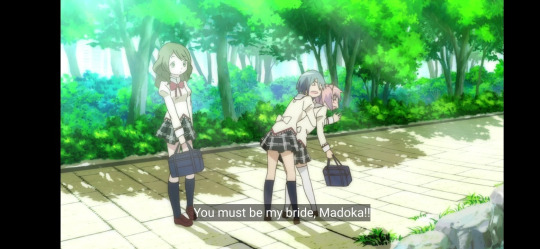
[Image id: Screenshot showing Madoka, Sayaka and their irrelevant friend Hitomi at the park. Sayaka is hugging a slouching Madoka from the back, saying "You must be my bride, Madoka!".]
The Girl Talk in episode one continues as we follow Madoka’s commute to school with her two friends: the blue one, the to-be Magical Girl, Sayaka and this one random girl that I'm surprised it's even there. The banter and physicality to Sayaka and Madoka’s interactions is fun and warm, selling their chemistry as friends. And near the end, Sayaka playfully proclaims Madoka must be with her, which immediately brought to mind Revolutionary Girl Utena’s Shinohara Wakaba's own ambiguous, very physically affectionate date-play with Utena.
Rather than being a maiden in the sidelines, however, Sayaka is positioned as Madoka’s protector against Homura. Given Homura is fighting to be Madoka’s silent protector herself, this is unbelievably funny to me. When Madoka finds Homura's staring off-putting during P.E., she hides behind Sayaka. When Madoka— with Kyubey in her arms— is alone facing the inscrutable, darkness-shrouded, threatening Homura, the one who shows up to save her is Sayaka. When they're alone within the creepy labyrinth, Sayaka protectively embraces Madoka. When Madoka is worried that Homura might try to attack them at school, Sayaka offers to punch Homura. This antagonistic placing of Madoka's two protectors is hilarious, and I'm curious to see if the dynamic fizzles out as we delve into Sayaka's innermost wishes and struggles or if the tension will boil over into something interesting.
'Get behind me, Madoka! I got the fire extinguisher!'
Such a hilarious way to break the tension.
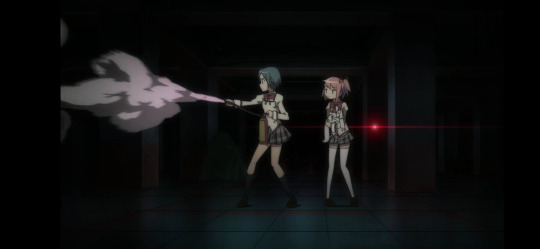
[Image id: Screenshot showing Madoka and Sayaka in a dark parking lot, with most of the background shrouded in shadows. Sayaka is holding a fire extinguisher that she's shooting towards the left, and Madoka stands behind her, holding Kyubey.]
Even their sitting order in class positions Madoka behind Sayaka lmao Does Sayaka have a thing for Madoka or just a hero complex?
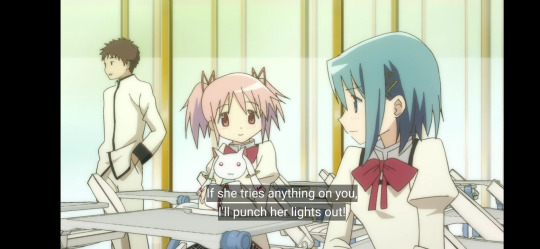
[Image ID: Screenshot showing Madoka and Sayaka sitting in their classrooom. Sayaka is shown sitting a row in front of Madoka, a column to the left. Madoka is holding Kyubey in her arms. The subtittles read: "If she tries anything on you, I'll punch her lights out!"]
The show acknowledges the homoeroticism between the two in a tongue-in-cheek manner during their commute in episode 2, when their normie friend feels put off by the apparent intimacy of their silent (telepathic) communication:
"You've been staring so intently into each other's eyes… What on earth did you do after I left yesterday?!"
This girl is too homophobic to become a magical girl, smh.
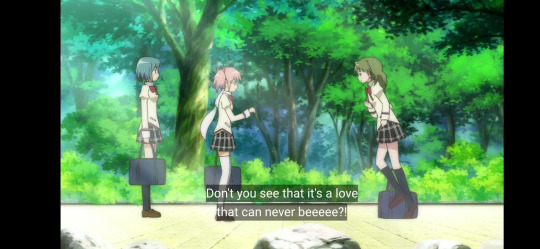
[Image ID: Screenshot showing Sayaka, Madoka and their friend Hitomi drawn in profile at the park. Sayaka and Madoka are positioned on the left side of the screen, with a tree in the background subtly serving as visual barrier between Madoka and Sayaka. Madoka is slouched and halfheartedly reaching to Hitomi. Hitomi is positioned on the right side of the screen, with her hand to her heart and running towards the left. Her dialogue reads: "Don't you see that it's a love that can never beeee?!"]
Madoka points out that their normie friend's remarks sound a lot like what Sayaka tells to her on a regular basis, lending credence to my Wakaba comparison lol This gag could simply be an acknowledgement of the charged homoeroticism present in the series, but it still amuses me so far a lot of it has circled around Sayaka and Madoka.
Akemi Homura
Her soundless, despaired scream as she catches sight of Madoka with Kyubey was so cinematic ❤️
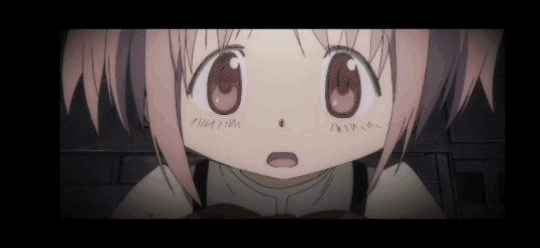
[Image id: gif showing a zoom out of Homura's face as she screams. She's resting on a tree branch that's represented as a black silhouette, with debris floating around represented in the same way.]
Speaking of homoeroticism, it's time to talk about Homura. I actually felt a little sad that I already know about her motivations because she's so incredibly off-putting, I'd have had a lot of fun speculating about the meaning of her actions, the way she's framed and the meticulous way her micro expressions are portrayed. However, it's not like there isn't still some room to have fun reading into them. She enters the picture via the classic transfer student trope. From her introduction alone, she creates an awkward atmosphere with the way the standoffish silence lingers due her laconicism.
Despite her aloof demeanor, and in pure transfer-student fashion, Homura still stands out both in academics and physical feats (she even breaks the regional high jump record lol!); as such garners the attention of her peers. Nonetheless, she couldn't be more uninterested in them, as the one she can't keep her eyes off is Madoka. Her taciturn, blank-faced and cutting demeanor can paint her staring as downright aggressive. This is further reinforced by being color coded with the darkest values in the cast so far: black and purple are her signature colors, classic villain palette.
Her conversation with Madoka as she rehashes the "could you show me where the infirmary is" routine is the big standout of hers in episode one —the tropey nature of this encounter makes it very easy to imagine how their first interactions went down the first time—. The low angle that emphasizes her head tilt and the accentuated shadows on her face and body make her look haughty and intimidating.
She's literally staring down Madoka lol Worth noting this same framing is repeated as she warns Madoka in a few minutes, complete with rotating animation for gravitas, contributing to Homura's bad vibes.

[Image ID: Screenshot showing Homura's face and shoulders slightly turned to the right side of the screen. The right side of her face is heavily shadowed and so are her shoulders. She's looking down on the viewer. Her dialogue reads: "May I ask you to accompany me?"]
While one could think that the reason she approached Madoka was to issue her warning, I'm actually not that certain. It could be due the way her anguished reactions to being around Madoka make her look quite erratic as she tortures herself with these distorted echoes of her memories—but I also have to point out the abrupt way she brings the interaction to a halt, stomping and suddenly turning. The way she behaves through the whole interaction feels quite impulsive, which gave me the impression of Homura purposefully trying to recreate the past (whether out of indulgence or to torture herself, I'm not really sure).
It's really fun the way this obscured close-up to her profile hiding her eyes— making it difficult to parse her emotions— paired to how the next highlighted extreme close-ups have her clenching her teeth led credence to the "Homura is a hostile party" narrative. Personally, the timing is what gets me. She reacts deeply upset to the fact Madoka politely yet impersonally addresses her as "Akemi-san" lol This girl was in the trenches.
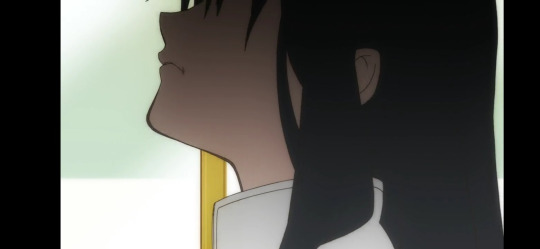
[Image ID: Screenshot showing Homura's shadowed profile facing left. She is holding her face up, seemingly imperious and her mouth is tightly shut.]
The way the timing makes it seem like she's really pissed at Madoka’s remark that her name is weird + subsequent fumbling is very funny lol I wouldn't say she's not upset from it, but mostly in the "it's painful to be around you" way.
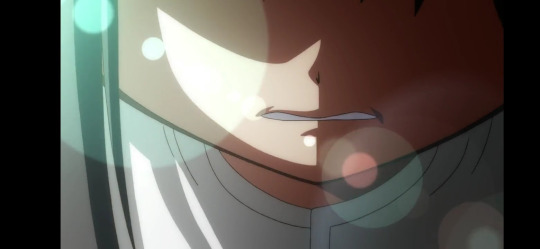
[Image ID: Screenshot showing a extreme close up to Homura's clenched mouth, as she lowers her face. There's heavy shading on the left side of her face and lens flare coming from the right side of her face.]
There's a lot of natural verticals in the panels of their classrooms and the windows they transverse that create visual divisions between the two. I found it particularly noteworthy that while there's a natural sense of distance and awkwardness between the them, Homura is the one who accentuates it and fully brings herself to the other side of the threshold when she suddenly skips forward ahead from Madoka. The idea she's intentionally cultivating a distance between the two is very intriguing and appealing…

[Image ID: Screenshot showing Homura and Madoka facing left as they walk through the corridor with blue window panes. There's a particular wide vertical division in between Madoka and Homura, placed more or less in the middle of the screen. Homura is on the left side of the screen, but closer to the blue vertical division. Madoka is falling behind, with more white space between her and the middle.]
Their sitting order reinforces this idea, situating Homura all the way to the front, completely out of reach.
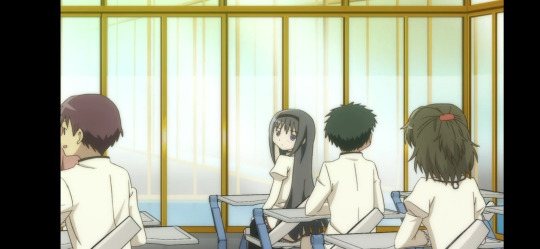
[Image ID: Screenshot showing Homura sitting in the front row, looking back at Madoka's seat.]
They look fully at odds with each other thanks to the high contrast between the bright windows and the shaded frames. The dark values to their visual barriers fully bring out the tension brought by Homura's sudden halt-and-turn as she issues her warning. Homura is framed as thoroughly oppositional to Madoka, and she herself doesn't bother to correct any misunderstandings. It's pretty interesting she's fine with being vilified if it might grant her any slight chance to get what she wants.

[Image ID: screenshot showing Homura and Madoka drawn in a symmetrical composition, separated visually by the regular window panes. Homura is drawn towards the left edge of the screen, facing right and standing imperiously. Madoka is drawn on the right side of the screen, towards the edge as well, slightly slouched and in a timid pose. Subtittles show Madoka's dialogue: "Yes, really! I couldn't lie about that."]
Homura's dead-eyed ominous warning vs Mami's personable, smiling offer of support, fight! But this is truly why I can't trust Mami lol Should you really be tacitly encouraging them, Yellow Senpai? A cutting warning really seems more befitting here…

[Image ID: Extreme close up to Homura's blank left eye with the right side of her face being heavily shaded. The subtittles read: "Because if you do, you will end up losing all of those things.]
Odd ends.
There's a lot of small gestures that really bring out charm to the interactions and feelings, but if I pointed out absolutely everything, I'd never finish this lol
There's one thing from the Madoka-wakes-up Bank I do want to point out, though: the odd feeling Madoka’s head turn with the hard shading gives me. Now, I know it's a Shaft™ thing, I've watched another TV series directed by Shinbo that was produced there and I've heard of it. But I still find the timing peculiar— after the opening sequence with her running to the rooftop in episode one and the brief recap with Mami's transformation in the second, just before she wakes up. Of course, this reinforces that sense of being at the verge of waking up from an odd dream, which Madoka fully believes, but it can also get a sense of deja vu. Typically, one would assume that Madoka’s run towards the rooftop is a glimpse to an event that will happen later down the line. But given the nature of this being a time loop and Homura's insistence on preventing Madoka’s death via preventing her contract altogether, which it's implied to happen in that sequence, I don't think there isn't any reason to think that it's not something that didn't already happen. If this ends up being the case, I'm curious how that'd affect further loops.
Tell me your secrets, you pink little one.

[Screenshot showing a extreme close up to Madoka's eyes facing towards the left. Her face is drawn almost facing front, leaning towards the right. There's heavy shading on her face and a black background.]
Expectations for the rest of the introductory arc:
-Second half of episode 2 will end in a cliffhanger that'll destabilize routine while they fight a new witch.
-Said cliffhanger will involve Mami (I HOPE IT DOES). I'm suspicious of her and hope she does something terrible, but I think it's equally, if not more, likely that something terrible happens to Her lol
-🤷🏻♂️
Hmm that's it. I'm not very good at imagining scenarios lol
I'm also half-expecting to be wrong about nothing making Madoka miserable, mostly because I've been obsessing over Takamachi Nanoha, another seemingly well-loved, normal kid who turned out to have Important Baggage lol
#pmmm#puella magi madoka magica#madoka kaname#Homura Akemi#Sayaka pmmm#Mami pmmm#so this post made me discover that the image limit is 30 pictures LMFAO#anyway i'm dead and i'm tired. I get it now. I need to save a back up of my file and images and write the img ids as i go#i'm dead#long post#like extremely long post#Mami Tomoe
37 notes
·
View notes
Text
100 epitaphs analysis rambles
mostly centered around symbolism of sanya's outfit changes but also touching on the baseball bat, the convergence cables, and a few strike 3 line retrospectives. (had to put it under the cut because it accidentally got really long, whoopsies!)
the two main outfits we see sanya in are her short yellow and black outfit with her hair down (which i will be referring to as "gymkid outfit") and her longer black and white outfit with her hair tied up (which i will refer to as "punk outfit").
in sanya's gymkid outfit we see her helplessness and youth, from the first time yura took her out to party [false disposition] to how she lays down seemingly caught in a grieving immobility. in her punk outfit however we see her defiance and her attempts to be "mature", raising the bat to protect KT when they first meet [parties are for losers] to her irreverent laughter while "a candle burns another photograph".
in convergence we see how yura views the cables binding the characters central to his plan of saving KT, sanya is here in her gymkid outfit, as much as he cares for her she's still a helpless kid getting tied up and held back by all that's going on. but in 100 epitaphs we see how sanya views this situation, seemingly accepting the cables and embracing them. she welcomes them, they don't restrict her, they comfort her, enabling her to get stronger, to be better at fighting the world.
also take note of the baseball bat, in convergence she isn't touching it but still tied up with her, out of reach but inescapable. whereas, in 100 epitaphs we see and hear how yura taking the bat in his hand kicks up the music, that audible ignition of firey rebel spirit, and when the cables enwrap her she wraps herself around the bat, holding it tight to her, refusing to let it go, that symbol of anything and everything she might be able to do to change things, to use what little power she has and release the frustration she's built up against the cruelty of the world.
this outfit symbolism is also shown in how sanya was wearing her gymkid outfit while she was on call with yura during the "negotiations" in convergence. she had very little actionable power in that situation, her presence was concealed and then almost immediately forcibly removed as soon as it was revealed. even down to the tiniest detail of yura's contact photo of her being her wearing the punk outfit and how that's the outfit she wears when she confronts dmitry in 100 epitaphs, these little attempts at displaying strength.
these outfit specifics even go back to young!sanya tying her hair up in preparation for the funeral, probably her first real experience of having to be mature. the facial expression change between young!sanya and present!sanya there is also very telling, young!sanya's frown is so sad, so unsure. this is contrasted by what we can see of present!sanya's frown, it's a lot sharper, a lot more sure of itself, somewhere between determined and disgruntled, she's gotten used to trying to be mature but that doesn't make it easier, she's just pushing through it harder.
but of course, yura and sanya's views of her aren't the only ones we see in 100 epitaphs, we also see sergei's perception of her as they stand back to back. here she's in her punk outfit, but it's incomplete, her hair is down, she can't fully commit herself to this, it's not who she is (or maybe she shouldn't commit herself to it and it's not who she should be).
on the topic of sergei it is SO COOL how strike 3's presence is all over 100 epitaphs. from the tepid autumn day to the motif while sanya and sergei are back to back, even how they both start with a phone (olga calling vs yura disconnecting). and they way strike 3 foreshadowed that final scene in 100 epitaphs in a way to make the exact way those lines would turn out ambiguous is damn near masterful.
"everything will pass, the edge will dull, i know what's best for you, and after all a day will come, warm and bright when i, tear down this dismal shelter wall." hearing this we're lead to believe a few key things: that sanya's edge will dull, and that this tearing down of the dismal shelter wall will be a strong and resilient action.
and yet in 100 epitaphs, it is not sanya's rebellious edge that dulls, but sergei's protective one. he realises that trying to protect sanya like this is just pushing her further away from him, he knows what's best but he's given up on trying to make her see that, the shelter wall is torn down not in triumph, but in resignation, collapsing under it's own weight.
"just hide behind this back of mine and save your helpless spite" this is framed like sergei asking sanya to let him protect her and to save that spite she feels for times where it might be of more use than as the weapon of an angry teen. in 100 epitaphs we see how sanya grabs onto sergei's back, to prevent him from punching yura, saving the embodiment of helpless spite.
can you tell i FUCKING LOVE THIS SERIES
#pafl#100 epitaphs#ferry vocaloid#pafl sanya#sanya kazarina#pafl convergence#pafl strike 3#parties are for losers#false disposition#pafl yura#yura beletsky#pafl sergei#sergei kazarin#nopanamaman#pafl 100 epitaphs#100 epitaphs pafl#character analysis#media analysis
71 notes
·
View notes
Text
Three Books One Plot FAQ
Who are you?
Hosts Shannon and G are both relapsed 2000s twihards from the DC-Maryland-Virginia area of the US who found their way back to Twilight fandom just in time for the Renaissance™. They met through fandom in 2019 and have been friends ever since!
Shannon (@flowerslut) lives and works in LA. When she’s not obsessively writing 250k-word fanfictions, you can find her at Emo Nite LA or making her own music under the name Maybe. Her personal blog is @uncancellable. You can also follow her on Goodreads/Storygraph!
G (@volturialice) lives in Colorado and works remotely, which leaves plenty of time for her to take long walks in the mountains and look for loose bears in the neighborhood. She is a graduate of the Fanauthor Workshop and spends a shocking amount of time at the library. You can follow her on Goodreads/Storygraph here!
What is Three Books One Plot?
3B1P (2022 - present) is a podcast created to compare and contrast Twilight and its two published rewrites: Life and Death: Twilight Reimagined (genderflipped Twilight) and Midnight Sun (Twilight from Edward’s point of view.) One part literary analysis, several parts jokes, and the rest utter shenanigans, it’s a bimonthly read-along in which hosts G and Shannon take turns reading and recounting chapters of Life and Death/Midnight Sun, and a rotating guest of the week reads and recounts Twilight. For more information on the podcast's genesis and the history of the three books, give Episode 0 a listen!
Where can I listen?
You can find us on Spotify, Apple Podcasts, Amazon Music, and Pocket Casts.
Are you planning to do episodes on Eclipse/Breaking Dawn?
Yes! Season 3 (Eclipse) will run from September 11th, 2024 (Happy birthday Renesmee) through the end of November 2025, with a few brief hiatuses. We are planning a Breaking Dawn season/Season 4, but dates are still TBD!
How have you kept your “three books” gimmick going into Season 2 and beyond?
In Seasons 2 and 3, we've kept Midnight Sun and Life and Death traditions alive by writing our own fake sequels (New Moon: Euphoria and Agony and Dark Noon, Eclipse: Warfare and Peace and Corona Light) from Beau's and Edward's POVs! G and Shannon take turns writing a chapter of each book and read them aloud on the air after each episode's normal chapter discussion.
For Season 3 (Eclipse,) we are also simultaneously be reading The Short Second Life of Bree Tanner! Look for Bree-inclusive episodes starting in March 2025, when the timelines converge.
When do you post new episodes?
We post new episodes every other Monday! Season 1 of 3B1P aired from June 2022 through May 2023, while Season 2 (New Moon) aired September 2023 through June 2024. Season 3 (Eclipse) will air September 2024 through November 2025 (reverting back to Monday releases after a Wednesday, September 11th premiere.)
Why do you have an episode 0/8.5/11.5? And why is your season 1 finale/season 3 premiere episode longer than Return of the King (2003, dir. Peter Jackson)?
Listen, we never claimed to be perfect.
What are the "show notes" and where can I find them?
After each episode, we compile any references we or our guests made into a post full of links, images, videos, articles, etc. Find them on our tumblr here!
How can I support the podcast?
You can slide us a few bucks over on the 3B1P Ko-fi. Anything we raise that goes over the cost of breaking even will be donated to the Quileute tribe’s Move to Higher Ground project! If you’d rather not shell out, we’d also love getting ratings/reviews on your listening platform of choice. Or you can recommend us to your goofiest friends!
Where can I find you on social media?
We post (and reblog) the most stuff here on our tumblr, but we also have an Instagram, TikTok, and previously had a (now-defunct) Twitter. You can also contact us with inquiries or long-form comments and letters at [email protected] 🤩
How can I interact with the podcast?
We love responding to tumblr asks, emails, and other comments! Sometimes we even read out comments during an episodes. We also post weekly polls and short-answer questions both here and on Spotify (only accessible from the mobile app.) We even occasionally host contests and challenges! You can also join our spinoff project Bella’s Book Club, a virtual book club open to anyone, which meets on discord once a month in order to discuss “Bella Swan’s” (Stephenie Meyer’s) favorite books as listed in Midnight Sun chapter 11 (and sometimes watch movies!) More info on Bella's Book Club can be found on its dedicated tumblr (here) Goodreads (here) and Storygraph (here!)
46 notes
·
View notes
Text
Of Dragons and Maelstroms


Themes and Warnings: slow burn, enemies to lovers, blood, violence, explicit language, sexual violence, period-typical misogyny, sexual themes, smut, tension, marriage, jealousy, pregnancy, childbirth, miscarriage, attempted sexual assault, breastfeeding, major character death, divergent timelines
Disclaimer: I do not own any of the House of The Dragon/Fire & Blood/Game of Thrones characters nor do I claim to own them. I do not own any of the images used nor do I claim to own them.

Chapter Fourteen
With a dagger secured at her hip and a flickering candle in hand, Maera's footsteps were a whisper against the cool stone floors. The corridors, once familiar, now seemed like a labyrinth, each turn leading her deeper into a maze of contemplation and solitude. The candle's soft glow cast dancing shadows that played across the walls like ethereal specters. As she roamed the Red Keep's hallowed halls, memories, both cherished and painful, played like ghostly apparitions before her eyes.
One such memory transported her back in time, to days when laughter echoed through these very halls. Aemond, Maera, and Helaena raced down the corridor in fits of joyous laughter, their youthful exuberance a stark contrast to the solemnity of the present. The prank they had played on Aegon, placing one of Helaena's millipedes on his pillow, had led to shouts and curses that resounded down the hall. Another memory unveiled itself, one of Aemond passing Maera and Helaena in these very halls. His gaze remained distant, his one eye void of the warmth and camaraderie that once defined their friendship. It was a reminder of how much had changed since that fateful day when Aemond lost his eye.
A third memory stirred within her, casting a poignant light on her wandering thoughts. Maera found herself carrying a platter of apple fingers from the kitchen, a craving of Queen Helaena during her first pregnancy, shortly after her wedding to Aegon. The simple act of delivering a favorite snack to her queen held a sense of warmth and familiarity, a time when their bond had been unburdened by the weight of courtly duties. The final memory that surfaced was more recent, a stark contrast to the previous ones. Maera saw Aemond passing her in the halls, her clothes stained with small blood splatters after assisting Helaena during childbirth. Aemond had inquired about the birth, and Maera had informed him that the queen had given birth to twins—a boy and a girl. His response had been a simple hum of acknowledgment before he continued on his way.
As the memories stirred a myriad of emotions within her, Maera's footsteps continued to echo in the empty halls. The past and the present converged, creating a tapestry of experiences that defined her journey within the Red Keep. And now here she was, her life more complicated than ever. Maera's restless wandering through the corridors of the Red Keep eventually led her to a hidden balcony that overlooked the city.
Leaning against the cool stone railing, Maera wrestled with the tangle of emotions that threatened to consume her. She longed for her home at Rain House, the memory of her brothers and sisters a bittersweet ache in her heart. The familiar comforts of her family and the simpler life she had once known beckoned to her from across the distance.
But anger simmered within her, an ember of frustration that flared to life. Her father's intentions weighed heavily on her, his view of her as a pawn in a political game stirring resentment. She refused to be reduced to a bargaining chip in the power struggles of men, for the sake of alliances and a chance to be near that ugly Iron Chair.
And then there was Aemond—a complicated figure who had occupied her thoughts far more than she cared to admit. His arrogance and cruelty clashed with the admiration she held for the one man who had challenged her as a warrior. It was a bitter pill to swallow that he, of all people, was the one who respected her skills and dared to engage with her on an equal footing. Yet, there was an unsettling undercurrent, a truth she couldn't deny—the pull he had on her, both physically and emotionally.
The irony was not lost on her—the very man she held in contempt had taken root in her most deep and intimate thoughts and fantasies. It was a maddening contradiction, a battle between her desire to resist and the unbidden fantasies that stirred beneath the surface. The cool night air whispered against her skin, offering a moment of solace amidst the storm of emotions. She closed her eyes, her thoughts a tumultuous sea of longing, anger, and frustration.
"Ziry iksos daor wise syt nykeā riñnykeā naejot hen mērī rȳ bantis jēda” It's rather improper for a lady to be out alone at night, A thick Valyrian accent purred in the darkness. Maera rolled her eyes at the comment, choosing not turn around or dignify it with a response as she continued to gaze at the stars.
Undeterred, Aemond settled beside her on the balcony, his presence a reminder of the intricate dance that defined their relationship. "But, as you’ve demonstrated on more than one occasion, you're no ordinary lady, Maera," he remarked with a hint of amusement. "You can definitely hold your own."
A small, knowing smile tugged at Maera's lips at his acknowledgment, but she kept her gaze fixed on the night sky. She held her shawl closer to her as a slight breeze filled the empty air. Aemond, tired of Maera not responding, turned his questioning to her well-being, an uncharacteristic move. "How is your chest?"
Maera's hand instinctively moved to part of her night dress, where underneath the bandaged wound lay, her fingers grazing the fabric. "It wasn't deep. I'll be fine."
Silence once again filled the air and Maera found peace within herself, even stood next to the one-eyed Prince. The balcony became a secluded sanctuary beneath the sprawling tapestry of the starlit sky. The city of King's Landing, usually bustling with activity, lay below her, but from this vantage point, it was nothing more than a distant hum.
In the stillness of the night, they stood side by side, their silhouettes framed against the shimmering canvas of stars. Maera's gaze remained fixed not looking at the silver-haired Prince, the complexities of her feelings for him a tangled web she could not unravel. But for now, she savored the quiet, the serene moment they shared. It was a fragile respite from the storm of emotions that had roiled within her for so long.
But Aemond, ever cruel and unpredictable, wasted no time in disrupting her moment of peace, his next comment veering into more treacherous territory. "Your skill with the sword is impeccable, although you may find it difficult to attract a husband. Most men don't like to be bested by a woman."
Maera's response was laced with a bitter undertone. "Do you think I honestly care about attracting a husband, Prince Aemond? I pray to the old Gods and the new that I’ll never have to succumb to such a fate."
Aemond's smirk, ever present in their conversations, remained as he continued, "My, won’t your father be disappointed? Perhaps the rumors about you will work in your favor."
Maera's patience waned, her emotions simmering beneath the surface. “I’m done playing these games with you. Enjoy your evening skulking about the Keep” she retorted, her voice laced with irritation and frustration. She turned to walk away, to distance herself from his unwelcome presence.
Aemond's voice called after her, his words dripping with a cruel curiosity. "Oh come now, my Lady, don't be coy. I'm genuinely curious about your experience with the man who sullied your honour”
The knight Aemond was referring to was Ser Olyver Trant, a man swore to her fathers guards. Of course Ser Reginald Penrose would pick a man who was close enough to her family to involve in his slanders. Olyver was a companion of Maera’s older brother, Dermot, but to those in the know, they were paramours.
When Dermot went to explore Essos, it was decided that Olyver would join in him three moons time as to not raise suspicion of their inappropriate relationship. And whilst he was waiting for her brother to call him, Olyver and Maera became good friends and enjoyed hunting and sparring together. Scorned by Maera’s rejection, Ser Reginald spread rumours about Olyver claiming Maera’s virginity, to prevent her from attracting any advantageous marriage pacts. If Reginald could not have her, he would take great pleasure in tarnishing her honour and reputation.
Maera would not breathe life into these accusations against her. If she did, she would not be believed anyway and it would mean also bringing dishonour to her brother Dermot or her House. Instead, Maera whipped round and glared defiantly at the one-eyed Prince, refusing to give him the satisfaction of a reaction.
Aemond took a step towards her, his eye locked onto hers with an intensity that sent a shiver down her spine. His questions grew bolder, each word laced with a dangerous desire that set her on edge.
“I wonder, did he take you gently in those stables? As every maiden dreams?” he inquired, his tone dripping with mockery. Maera's silence and scowl were her only response, her rage building like a storm within her.
The prince took another step closer, his imposing presence now casting a shadow over her. The height and proximity sent Maera's heart racing, her breath quickening. His questions persisted , each word a calculated jab that sought to unravel her composure. "Or perhaps," he paused, smirking to himself, "it was rough and merciless, driven by unbridled desire?”
The words hung in the air like a challenge, a dangerous game that stirred Maera’s fury to new heights. Aemond's closeness, his taunting words, his twisted perverse mind games. She couldn't bear his intrusive questions any longer. Aemond closed the distance between them, their bodies almost touching. Her breath quickened, her body reacting to his proximity and the unnerving intensity of his gaze.
“Maybe, Maera” he murmured, before leaning in closer, his lips brushing against her ear, his words a cruel whisper. “Maybe you enjoy it that way”
Maera's rage ignited like a wildfire, the ember of her anger bursting into full-blown flames. She raised her hand to strike him, an impulse driven by fury and frustration. But Aemond was faster, his arm intercepting hers and pulling her closer to him. Maera struggled against his grasp, her heart pounding with a mixture of rage and fear. The proximity of his presence was suffocating, her breath catching in her throat as their eyes locked in a fierce, unspoken battle.
The balcony, once a sanctuary of peace, had become a battlefield of conflicting emotions, and she found herself ensnared in a confrontation she had not sought nor wanted. Aemond's taunting questions about the nature of her experiences were like daggers, each word a painful cut that stoked the fires of her rage. And she hated him for it.
Aemond's presence, both alluring and intimidating, left Maera grappling with the storm of feelings that raged within her, a tempest that threatened to consume them both. But tense standoff between Aemond and Maera was abruptly shattered by a deafening roar that reverberated through the night air.

Note: Ahhh the tension! Also my uploads are going to be slower as I’m working mad shifts. Hopefully it adds to the anticipation 😉
Thank you so much for reading! Comments, feedback, likes, and reblogs are greatly appreciated 🖤
#maera wylde#aemond fanfiction#aemond targaryen#aemond x oc#chapters#hotd aemond#hotd fanfic#hotd helaena#house targaryen#house wylde
52 notes
·
View notes
Text
youtube
From Conflict to Convergence: The Cultural Relationship Between Rome and Greece 🌟
The relationship between Rome and Greece is a tale of two civilizations that, while distinct, became inextricably linked through centuries of interaction. From early political structures to cultural exchanges, the evolution of this relationship is a fascinating journey through history. Let’s explore how Rome and Greece influenced each other and the lasting impact of their intertwined destinies.
The Birth of Political Parties and Governance 🗺️
When we talk about the origins of political parties, Greece is often recognized as one of the earliest civilizations to experiment with various forms of governance. The Golden Age of Greece, which thrived around the 400s BC, was a time of democratic innovation, particularly in Athens. This period saw the emergence of political factions that debated issues of governance, laying the foundation for modern political systems.
Rome, emerging as a republic in 509 BC, overlapped with the tail end of Greece’s Golden Age. By the time of Julius Caesar, Greece’s political landscape had undergone significant changes. The once-united city-states had splintered into smaller kingdoms following the death of Alexander the Great in 323 BC. This fragmentation made Greece vulnerable, and Rome, ever the opportunist, began to absorb Greek culture and influence, albeit with some initial reluctance.
Cultural Differences and Initial Resistance ⚔️
In the early days of the Roman Republic, Greek culture was often viewed with suspicion and disdain. The Romans, known for their martial discipline and austerity, saw Greek customs as overly indulgent and effeminate. Greek men, with their long hair and beards, and their love for music, theater, and the arts, were a stark contrast to the Roman ideal of the stoic, battle-hardened warrior.
This cultural clash was evident in Roman society’s view of actors, who were placed at the bottom of the social ladder. Unlike in Greece, where actors enjoyed respect, in Rome, associating with actors was seen as a sign of weakness. This disdain for the arts reflected Rome’s early values, where strength and military prowess were paramount.
Yet, despite this initial resistance, Greek culture began to permeate Roman society. As Rome expanded its empire, it encountered Greek customs that, over time, proved too valuable to ignore. By the mid-Republic, the Roman elite had begun to adopt Greek practices, from fashion to language. Speaking Greek became a mark of sophistication, and even the once-ridiculed beards became a symbol of intellectualism among Rome’s upper classes.
The Influence of Greek Culture on Rome 🎨
The shift in Roman attitudes towards Greek culture was gradual but profound. The Romans, always practical, recognized the benefits of incorporating Greek ideas into their own society. This was particularly true in the realms of philosophy, art, and religion, where Greek influence became deeply embedded.
One of the most significant cultural imports from Greece was the concept of ruler worship, a practice the Greeks had adopted from Eastern civilizations like Babylon. Alexander the Great, the Macedonian conqueror, embraced this practice after encountering it in Babylon, where rulers were often deified. His adoption of proskynesis—a ritual in which subjects would prostrate themselves before him as a sign of reverence—was a stark departure from traditional Greek customs but eventually found its way to Rome.
By the time of Emperor Diocletian in 284 AD, proskynesis had become an established practice in the Roman Empire, highlighting the extent of Greek influence on Roman culture. This evolution in religious and cultural practices underscores the deep connection between these two civilizations, despite their initial differences.
The Enduring Legacy of Cultural Exchange 📖
The relationship between Rome and Greece was not a one-sided affair. While Rome absorbed many aspects of Greek culture, it also left a lasting impact on Greece. Roman advancements in architecture, engineering, and law profoundly influenced Greek cities and governance, shaping the course of Western civilization.
Today, the legacies of Rome and Greece are intertwined, with each civilization having left its mark on the other. Their relationship, marked by both conflict and convergence, serves as a powerful reminder of the transformative power of cultural exchange.
In our increasingly interconnected world, the story of Rome and Greece offers valuable insights into the importance of embracing and adapting to different cultures. As we navigate the complexities of global interactions, we can draw inspiration from these ancient civilizations, learning from their experiences as we shape our own future.
4 notes
·
View notes
Text



A new view of the North Star
Researchers using Georgia State University’s Center for High Angular Resolution Astronomy (CHARA) Array have identified new details about the size and appearance of the North Star, also known as Polaris. The new research is published in The Astrophysical Journal.
Earth’s North Pole points to a direction in space marked by the North Star. Polaris is both a navigation aid and a remarkable star in its own right. It is the brightest member of a triple-star system and is a pulsating variable star. Polaris gets brighter and fainter periodically as the star’s diameter grows and shrinks over a four-day cycle.
Polaris is a kind of star known as a Cepheid variable. Astronomers use these stars as “standard candles” because their true brightness depends on their period of pulsation: Brighter stars pulsate slower than fainter stars. How bright a star appears in the sky depends on the star’s true brightness and the distance to the star. Because we know the true brightness of a Cepheid based on its pulsational period, astronomers can use them to measure the distances to their host galaxies and to infer the expansion rate of the universe.
A team of astronomers led by Nancy Evans at the Center for Astrophysics | Harvard & Smithsonian observed Polaris using the CHARA optical interferometric array of six telescopes at Mount Wilson, Calif. The goal of the investigation was to map the orbit of the close, faint companion that orbits Polaris every 30 years.
“The small separation and large contrast in brightness between the two stars makes it extremely challenging to resolve the binary system during their closest approach,” Evans said.
The CHARA Array combines the light of six telescopes that are spread across the mountaintop at the historic Mount Wilson Observatory. By combining the light, the CHARA Array acted like a 330-meter telescope to detect the faint companion as it passed close to Polaris. The observations of Polaris were recorded using the MIRC-X camera which was built by astronomers at the University of Michigan and Exeter University in the U.K. The MIRC-X camera has the remarkable ability to capture details of stellar surfaces.
The team successfully tracked the orbit of the close companion and measured changes in the size of the Cepheid as it pulsated. The orbital motion showed that Polaris has a mass five times larger than that of the Sun. The images of Polaris showed that it has a diameter 46 times the size of the Sun.
The biggest surprise was the appearance of Polaris in close-up images. The CHARA observations provided the first glimpse of what the surface of a Cepheid variable looks like.
CHARA Array false-color image of Polaris from April 2021 that reveals large bright and dark spots on the surface. Polaris appears about 600,000 times smaller than the Full Moon in the sky.
“The CHARA images revealed large bright and dark spots on the surface of Polaris that changed over time,” said Gail Schaefer, director of the CHARA Array. The presence of spots and the rotation of the star might be linked to a 120-day variation in measured velocity.
“We plan to continue imaging Polaris in the future,” said John Monnier, an astronomy professor at the University of Michigan. “We hope to better understand the mechanism that generates the spots on the surface of Polaris.”
The new observations of Polaris were made and recorded as part of the open access program at the CHARA Array, where astronomers from around the world can apply for time through the National Optical-Infrared Astronomy Research Laboratory (NOIRLab).
The CHARA Array is located at the Mount Wilson Observatory in the San Gabriel Mountains of southern California. The six telescopes of the CHARA Array are arranged along three arms. The light from each telescope is transported through vacuum pipes to the central beam combining lab. All the beams converge on the MIRC-X camera in the lab.
TOP IMAGE: CHARA Array false-color image of Polaris from April 2021 that reveals large bright and dark spots on the surface. Polaris appears about 600,000 times smaller than the Full Moon in the sky. Credit Courtesy: Georgia State University / CHARA Array
CENTRE IMAGE: The CHARA Array is located at the Mount Wilson Observatory in the San Gabriel Mountains of southern California. The six telescopes of the CHARA Array are arranged along three arms. The light from each telescope is transported through vacuum pipes to the central beam combining lab. All the beams converge on the MIRC-X camera in the lab. Credit Courtesy: Georgia State University / CHARA Array
LOWER IMAGE: The CHARA Array is a six-telescope facility located at the historic Mount Wilson Observatory in California. Credit Courtesy: Georgia State University
3 notes
·
View notes
Text
Decency in the abstract is quite different from the questions that press on us when hundreds of thousands more children are under the bomb sights.
Gabriel Winant in Dissent. On Mourning and Statehood: A Response to Joshua Leifer
How to grieve, what meaning to give those tears, is cruelly a political question whether we like it or not.
Editor's notes at Dissent: This is a response to “Toward a Humane Left” by Joshua Leifer. You can read Leifer’s reply here.
Joshua Leifer in his reply states: "the task of the hour is to oppose with every effort Israel’s assault on Gaza, to protest the horrific war crimes, and to demand an immediate end to the war. "
Contrast these conversations with Lindsey Graham going on Fox News to incite genocide: "Level the place." Official US policy is regreatably convergent with Graham's incitement. It's also viewed by many as moral clarity.
8 notes
·
View notes
Text
The struggle between Buddhism and Confucianism came to a head several times in history, leading to several harsh crackdowns on the Buddhist establishment, with the consequences that thousands of monasteries were destroyed and hundreds and thousands of monks and nuns forced to return to secular life. During the reign of the Emperor Wu of the Tang, the Buddhist establishment was dealt a devastating blow. According to historical accounts, however, the school of Chan escaped from the destructive suppression because Chan practitioners did not follow the conventional Buddhist practice of a parasitic life in magnificent monasteries in or near the cities but established their temples in deep mountains far from the madding crowd and engaged in farming and producing food and daily necessities for their own consumption, thus substantially changing the parasitic nature of Buddhist existence.
[...]
After Buddhism was introduced into China, it was considerably helped by Daoism, but it has some irreconcilable differences from Confucianism. At the heart of the differences is the conflict between the Confucian worldliness and Buddhist otherworldliness.
Confucianism stresses the social being of a person in society, who is obliged to play his or her social roles in various capacities and makes contributions to society’s well-being. By contrast, Buddhist monks and nuns are persons who leave home, sever family ties, cut off social relations, and disentangle themselves from social life. They do not produce material things or reproduce human beings, actually leading a parasitic existence. Because of this, Buddhism came into direct conflict with Confucianism and went through several large-scale persecutions.
Unlike other schools of Buddhism which encourage people to reject families and social relations, the Chan school adopts the Confucian idea of worldliness and encourages people to stay at home, engage in social affairs, and treat daily routines as a way of cultivation, thus changing the nature of Buddhist existence. This helped Chan Buddhism survive the religious persecutions and gain popularity.
[...]
Huineng is the first to advocate the worldliness of Chan. In the Platform Sutra, he declares:
“From the outset the Dharma has been in the world; Being in the world, it transcends the world. Hence do not seek the transcendental world outside, By discarding the present world itself.”
[...]
With this worldly view of the Dharma, he dissuades people from taking religious orders as monks and nuns and instead advocates Chan practice as laymen at home:
Good friends, if you wish to practice, it is all right to do so as laymen; you don’t have to be in a temple. If you are in a temple but do not practice, you are like the evil-minded people of the West. If you are a layman but do practice, you are practicing the good of the people of the East.
As a result of assimilating the Confucian worldliness, Chan and life converged to such an extent that Chan becomes a form of life and life a form of Chan. There are many anecdotes and stories about life as Chan. Here, one example suffices. In his sermons to his disciples, Linji admonished them:
Followers of the Way, Buddhism requires no special efforts. You have only to lead your everyday life without seeking anything more – piss and shit, get dressed, eat your rice, and lie down when you are tired. Fools may laugh at me, but the wise understand.
-- Ming Dong Gu, The Nature and Rationale of Zen
3 notes
·
View notes
Text
Book Review: 'The Saga of Tanya the Evil' #11
The Saga of Tanya the Evil, Vol. 11: Alea Iacta Est by Carlo Zen

alternate history
fantasy
magic
social commentary
violence
war fiction
My rating: 4 of 5 stars
An intellectual schism rests upon the bent-over shoulders of a waning nation's exhausted military. This nation, gaunt from the excess patriotism that war brings, and this military, feeble from having run through its many resources, now lean a bit too heavily into one another, bleary-eyed and uncertain as to which way is up. But this schism. It, too, is ghastly, somnolent, and a bit weary from all the blood and rhetoric. It haunts those who would venture to proclaim, to any who would dare listen, that a solution exists that can put an end to this total war. For readers who have crawled this deep into the trenches with Zen, THE SAGA OF TANYA THE EVIL v11, unsurprisingly, reveals this debate is not about determining which of the two sides is correct; the true challenge of an intellectual schism rests in determining which of the two sides has the power and the will to outlast the other.
And then there's "Plan B." Lieutenant Colonel Tanya von Degurechaff is an unwilling witness to the convergence and deflection of contrasting ideas helmed by the generals Rudersdorf and Zettour. THE SAGA OF TANYA THE EVIL v11 marks the third volume the author has teased this traitorous curiosity in earnest, and readers finally see Tanya bear its full weight. Rudersdorf views the Empire's only way forward through a traditional coup d'etat — the armed/military overthrow of the nation's established governing bodies. It's deliberate; it's a hard landing; it involves making everyone the enemy. Zettour views the Empire's inevitable end more harmoniously — the affectionate intertwining of diplomatic arrogance and the revered antecedent of military gusto. It's academic; it's a soft landing; it involves contingency plans for allies and enemies alike.
But the damage has been done. As Tanya learns in the novel's opening chapter, which comprises 50 pages of debate, a nation whose leadership strides uncompromisingly into anything will surely fail. There is no respect to be had by a nation whose entire youth was burned to death by the flames of war. There is no humble concord to be maintained for the political institutions whose only lingering pride is defined by their erstwhile shortsightedness. There is no victory to be won by military enterprises whose veil of sincerity has worked so damn well, that nobody, even among its most learned and accomplished ranks, will internalize the truth before it is rendered irrelevant.
Whether the empire strives for an impractical, unattainable victory (Rudersdorf) or an extended, neglectful defeat (Zettour), the end is the same. The only difference rests in discerning the extent to which these leaders' insufferable egos will bend to accommodate reality.
THE SAGA OF TANYA THE EVIL v11 discusses this schism at length, only to later devour both semblances whole and forge a third, synthesized version that compels the characters forward. Narratively speaking, this means broaching the question of the Kingdom of Ildoa. Does the Empire invade? Does it invade right now? Does the military suppress the politicians and royalty in its own territory first? Does one branch of the military, the army, impose its will over others? Why won't anybody do anything about the leaked codes?
The Ildoa question has been a non-issue for much of the novel series, and interestingly, or charmingly, the author also does so on purpose for half of the current novel. A series of dramatic and inconvenient events forces the Empire's hand. Specifically, forces General Zettour's hand. Which means Tanya and the Salamander Kampfgruppe will soon head to the amiable southern border at the onset of winter. Talk of treason, unwinnable war, and ad libitum diplomacy crumble under the auspicious blue skies of the Ildoan countryside.
Also, readers catch a deeper glimpse of two curious perspectives: Colonel Lergen and Colonel Colandro, of Ildoa. A full chapter of Lergen's post-war memoirs provides a crucial, if unbearably sad, but regrettably believable account of war-era bias and the self-blinding predilections of men in power.
For example, Counselor Conrad of the Foreign Office warned Lergen, "Diplomacy is... It's almost like alchemy in a way" (page 055), but the colonel's inability to extrapolate the correct meaning of this analogy quickly proves (validates) just how doomed the Empire truly was. Alas, diplomacy isn't about assembling presumptions; it's not about converting one's expectations into something more. Diplomacy is about cobbling together disparate demands; it's a patchwork of ideals, clumsily yet unerringly hammered into a single, substandard but workable truth.
As such, Lergen travels to neutral Ildoa to meet with his counterpart, Colonel Colandro, to discuss the terms of a possible armistice. And in doing so, he makes the ruinous mistake of believing the Empire a nation worthy of setting the pace. After all the Empire has done, does it possess the legitimacy to make demands? Refuse reparations? Declare revisionist borders? Debate a divestment of local political authority? It's a start. But it's not enough. It's nowhere near enough. And when Colandro explains these facts in plain terms, Lergen nearly passes out. The man isn't wrong, per se, merely ignorant. Only later, much later, will Lergen realize the dissolution of war is not enough comfort for those affected by such disaster; only the dissolution of the social, military, and political hierarchies responsible for war will do.
Appropriately, THE SAGA OF TANYA THE EVIL v11 gives readers an idea of the challenges facing their opponents on the peninsula. Colonel Colandro, comfortable in the Ildoan capital, struggles to alert his comrades of the changing balance of power happening in the nearby Empire. But it's not entirely his fault. In a clever narrative twist, one learns that just as Lergen is biased in favor of imperfect reconciliation, so too is Colandro biased in his value estimation. That is to say, both men lack the intellectual diversity required to be more than what they are: cogs in a machine.
As for Colandro and his fellow Ildoans, "the issue, however, was that people often made assessments based on their own values. They believed that others thought the same way they did" (page 181). If one does not view a problem from the perspectives of all key stakeholders, then the solutions raised will be, invariably, inadequate. As such, in the case of the current novel, the consequences are necessarily, comically grand (e.g., An early warning of a coming invasion? No. Couldn't be. Wouldn't dare think of it. Not in a neutral nation.), for "any amount of effort put forward or attempt to resist an enemy invasion meant nothing without truly knowing what it meant to fight an enemy" (page 233).
And so, General Zettour returns to the capital, the Empire marches into Ildoa, Colonel Lergen finds his way to the southern front, and Tanya and her crew of misfits procure for themselves mouthfuls of bread, chocolate, sausages, eggs, and potatoes. This novel shifts the board of possible end-game scenarios for the Empire, but the picture is far from clear. Will war with Ildoa simplify negotiations, or will it complicate them? Will the turmoil between Zettour and Rudersdorf boil over and into the nation's political strata? Will Tanya take the bait of a promotion, only to be forced into compliance with orders she cannot support in good faith? Will a nation whose textbooks fear admission of failure ever learn how to properly process defeat?
❯ ❯ Light-Novel Reviews || ahb writes on Good Reads
#writeblr#review#the saga of tanya the evil#tanya von degurechaff#light novel#yojo senki#carlo zen#alea iacta est#tanya the evil#isekai#幼女戦記#war fiction#alternate history#fantasy fiction#lergen finds his way to the southern front#leadership strides uncompromisingly#intellectual schism
4 notes
·
View notes
Note
apologies in advice, i doubt this makes much sense, it is the product of a couple weeks occasional dot points or sentences, it is rather rambly, rather loose and just my thoughts. there is a little bit about ancient greek in there but not much, sorry. it is largely unedited, but i have cut out the most rambly/nonsensical parts, and so without further ado:
Throughout ancient Greek plays and stories, we see lives tossed away and wars fought over love, but conflict and corruption of the family still exists. We can see it in the family of Menelaus, when priorities of victory overcome love for a daughter, something which is punished by Clytemnestra when she murders her husband. But in Euripides’ Electra, the author questions this murder and subsequent treatment of Menelaus’ children. We are asked what crimes we can commit against family and still be valued, and yet no answer is delivered. We are asked what is a family when familial love is withheld. Cause and effect is clear and every character brings their own tragic reckoning upon themselves and this, i believe, is echoed within your work.
Your work features a perversion of brotherhood, love and violence in the relationship of warriors and the train kid, one which questions what love is and what it can be when morality is cast away under the guise of war.
In both cases, war is not a result of or a boon to love, but a corrupting force. Love and hate are painfully close together and in your story the characters dance across the line in a tango nearly indistinguishable from a battle. The ancient world poses tragic love as something of beauty, martyrdom as the peak of romance, but when to love is to die, what is it to hurt and harm? With every waking moment being life and death, love becomes an all-consuming agony, an ephemeral blaze unable to last til morning. One of my favourite things that this perversion and reframing does is that it questions the very constructs of love, familial, platonic, and romantic, especially under the lens of toxicity and broken concepts of love. We see it in Lincoln and link, with the bond of blood broken, and other constructs of familial support lost to link during the war of eras. And then later he receives familial support through the other heroes, a taste of familial love then strained by, well, the plot. And within the story he is allowed unconditional love and guidance, judgment, and disparagement, yes, but room for growth, for change. He is giving constants that will protect and care for him when it comes down to it, and is that then what family is?
With this concept of family, we can now examine the clusterfuck that is our three heroes during the war of eras, specifically that between Engie and link. The love between them is made condition and fluctuating, it isn’t an object of support, but a twisted distraction mangled into the form of a coping mechanism. The determination to be there for one another is near completely absent and because of it the engineer like… dies or something? Basically, it sucks. This contrast then asks us what is different, what in link’s perspective and experience has changed to allow this? The war? Distance from duty? The loss of the engineer? As a reader questions and analyses each change, they slowly begin to build an understanding and a concept of what love is, when it can exist and how it can be both corrupted and redeemed. One gains insight into how tragedy comes to be and are able to view the forces which converge to pervert what love is in our minds, for they are lonely places and can so easily become stifling.
This:
The ancient world poses tragic love as something of beauty, martyrdom as the peak of romance, but when to love is to die, what is it to hurt and harm?
And this:
The love between them is made condition and fluctuating, it isn’t an object of support, but a twisted distraction mangled into the form of a coping mechanism.
Made me SCREAM. This analysis is beautiful. Thank you so much for thinking so highly for my work <3
#every time you compare anything ctb to classical lit i just AHHHHHHHHHHHHH#I am nowhere near as eloquent as you omg#and sorry for posting this a little late i have had a very busy few days#thank you <3#me rambling#lu ctb#linked universe#ask#anonymous#ancient greek anon#uhhh so we need a ctb anylisis tag??#yeah why not#ctb analysis
12 notes
·
View notes
Text
Mastering the Art of One Point Perspective Photography | Tips and Techniques
Introduction
Being an ardent photographer, my goal is to discover various ways of capturing amazing views that would be attractive to the audience. In particular, the one-point perspective has become my favourite than any other perspective that can be used to create dramatic compositions. In this piece I'll be explaining the realm of one-point perspective photography, the concept, the technique and some tips so that you can achieve mastery in this artistic venture.
Understanding the Concept of One Point Perspective
The perspective photography technique that uses converging lines to represent depth and dimension is one point perspective. The essence of one point perspective is based on the rules of linear perspective, which was originated during the Renaissance. When through the camera alignment with single-point perspective vanishing point, the picture has the appearance of three-dimensional space.
To understand what of a one point perspective is, imagine yourself as the end of a long corridor with a single door at the extreme end. The corridor seems to have only one vanishing point, where all the lines gathered— they can be seen on the floor, wall, and ceiling. This is the key element in one-point perspective photo composition.

One Point Perspective Photography Techniques
Having the one point perspective as a basis, let's now talk about some techniques that will help you to explore the perspective photography. These techniques will cover not only your picture perspective, but it will also add to your portfolio perspective pictures that fascinate and bewitch.
Tips for Capturing One Point Perspective in Buildings
One-point perspective photography is ideal for shooting buildings because of their straight lines and symmetrical forms that give the best results. For architectural photography that will capture the attention of the viewer, compose the shot by aligning the building’s edges with the vanishing point. Playing with diverse angles and focal lengths, you will be able to add depth and drama into your one point perspective pictures, while the windows, archways and columns can bring complexity into your shots.
Creating Dramatic Effects with One Point Perspective in Black and White Photography
One-point perspective is minimalistic in design and the timeless appeal and dramatic effect of black and white photography perfectly complement it. When capturing perspective images in black and white, highlight textures, patterns, as well as contrasts to intensify the visual effects. Using different lighting techniques, such as chiaroscuro, you can create images with dark shadows that emphasize bright highlights and thus create a sense of mystery and beauty in the picture.
Finding Unique Locations for One Point Perspective Photography
Although buildings are often used for a one point perspective, try to look at things from a different perspective and do not restrict yourself to the traditional architectural style. Look for unique places in an urban setting or go for nature photography to get interesting perspectives and compositions. Bridges, staircases, tunnels, and even the straight tree trunks or the curved lines of mountains can all be used to take fascinating one point perspective photos. Walk around your surrounding with a sharp eye and a free heart to find the hidden treasures that lay ahead.
Using One Point Perspective to Capture a Dock or Pier
Docks and piers are admirable subjects for landscape photography, especially when using one point perspective. The wooden stakes that radiate out into the water can give your images a feeling of depth and distance. To catch a great picture, set yourself at the end of the dock or pier and match the lines with the vanishing point. Make sure you watch the reflections in the water and how light and shadows play in your composition, as they can be used to add atmosphere to your landscape photography.
How to Take One Point Perspective Photography
To capture compelling one point perspective photographs, follow these steps:
Find a subject with strong lines and depth.
Position yourself in a way that aligns the lines with the vanishing point.
Experiment with different angles and focal lengths to create depth and drama.
Pay attention to details and elements that can add interest to your composition.
Consider the lighting conditions and how they can enhance your photograph.
Take multiple shots from different perspectives to ensure you capture the best image.
Remember, practice makes perfect. Don't be afraid to experiment and try different techniques until you find your unique style and vision, drawing upon photography inspiration along the way.
One Point Perspective Landscape Photography
Although one point perspective is used for buildings and man-made structures, one point perspective can be used to take an exciting one point perspective photos and images in landscape photography. Search for natural elements in the forms of paths, roads, or rows of trees that will invite the viewer's eye to go further into the distance. The matter is how to locate a subject that produces a sense of depth and dimension, with lines that lead the viewer to the main point.
Editing and Post-Processing Techniques for One Point Perspective Photography
Now you have your one point perspective photo, it's time to awaken them to their full potential by editing and post-processing them. Here are some techniques to enhance your images:Here are some techniques to enhance your images:
Adjust the levels and curves to achieve the optimal tonal range and contrast.
Adjust colors to induce a certain mood or environment.
Sharpen image to make the details and the textures more visible.
Remove distractions and unwanted elements using clone or content-aware tools.
Try out various filters or presets to give your pictures the creative edge.
In case you edit the photograph, make sure it highlights your photo, not overshadows it. Use them as a starting point and your editing style will get developed with time.
Inspiration from Famous Photographers Who Use One Point Perspective
Looking for photography inspiration? Explore the works of famous photographers who have mastered the art of one point perspective. Artists like Ansel Adams, Henri Cartier-Bresson, and Michael Kenna have all incorporated this technique into their iconic photographs. Study their compositions, observe how they use lines and vanishing points to create depth and interest, and let their work inspire your own photographic journey.
Get Inspired for Your Next Project!
One-point perspective photography is a marvelous device that allows us to create beautiful and visually attracting images from this point of view. Use this technique if you are shooting anything from buildings and landscapes to everyday scenes. The technique adds depth and dimension to your photos. Experiment, practice, and let your imagination be your tutor as you bring one point perspective photography to the stage. Keep in mind that the journey itself is as much fun as the result, so enjoy the process and let your enthusiasm show.
Now, get your camera and go out to the city for street photography, discover the scenery around, and begin to take the world from a different angle!
1 note
·
View note
Text
From Care to Cure and Back
Under the umbrella of the LINA platform a program From Care to Cure and Back was initiated by Ana Dana Beroš in collaboration with the Association of Architects of Istria (DAI-SAI). "Treat, cure and give care again", is the idea behind this program, says Ana Dana and stress how important is to deal with experimental publishing practices in architecture.

Ana Dana Beroš at the Publishing Acts: The Publishing School Pedagogies of Care in Rijeka (2020). | Photo © Matija Kralj Štefanić
She is referring how care was and is missing in the formal education of architecture, in the form of a humanistic way of thinking and asking background questions, which primarily concern the users of buildings. With the construction of the state, public projects fell into the background. It became clear that we must learn from our own history, repair, preserve and take care together, and not build unnecessarily.
How will architecture change in the future?
ADB: It will change drastically. I ask myself all the time is it ethical to build anymore? Or should we be focusing on “the great repair” of the broken world? Or is it broken architecture, or mankind, or more than human environment? This question are arising because we were witnessing for more than half of century the capitalist modernity, with its emphasis on innovation, growth, and progress, its economic system based on consumerism and wasteful use, and profligacy, has led to a ruthless exploitation of humans and nature.
Architecture has played a huge small part in this, as the statistics on greenhouse gas emissions and construction and demolition waste prove. As a counter-strategy to capitalism’s creative destruction, we should focus on the repair, in which nurturing and maintenance that should become the key strategies for the action.
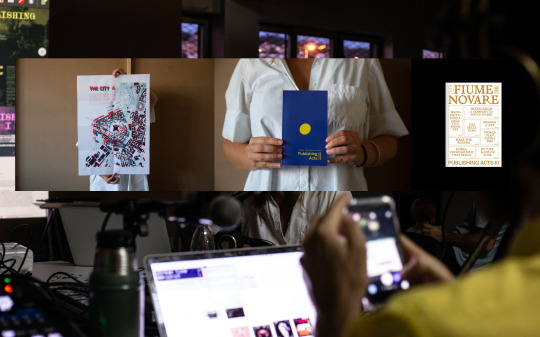
Publishing Acts I-II-III (2017-2020) | Photo © Matija Kralj Štefanić, collage Ana Dana Beroš
This is not just mine thinking, the notions of care in architecture have been part of many international exhibitions starting from the Critical Care at the Architektur Zentrum in Viena curated by Elke Krasny and Angelika Fitz, the term The Great Repair was used by Milica Topalović and her team at ETH, then are here Pedagogies of the Broken Planet. This is how I see the future.
What does your critical spatial practice include?
ADB: My critical spatial practice has components of artistic research, documentary filmmaking, curating, publishing/broadcasting, exhibition design, activism and post-disciplinary de-schooling. This is work that overlaps, diverges, converges, runs in parallel, in circles, and in many cases came before and goes beyond.
A whole multitude of practitioners and theorists have been developing work in an expanded field such as this, quite different perhaps from the one Rosalind Krauss identified in 1979. Critical spatial practice was coined by the theorist Jane Rendell in 2000s as a helpful way of describe projects located between art and architecture, that both critiqued the sites into which they intervened as well as the disciplinary procedures through which they operated.

LINA - DAI-SAI programme From Cure to Care and Back. | Photo © Ana Dana Beroš
Taking into account the wide spectrum of intellectual fields close to architecture and space - from urban anthropology to human geography - I consider connecting architecture with feminist theory crucial for the development of critical spatial practices. Gender-based analysis of architecture, its multiple forms of representation, where subjects and spaces are viewed as performatives and constructs, is aimed primarily at questioning the world around us.
Moreover, critical spatial practices are necessarily self-critical and tend to change society, in contrast to orthodox architectural practices that seek to maintain and strengthen the existing social and spatial order of inequality.
How is the LINA platform important for your development on architecture of care?
ADB: I have started Architecture of Care actually developing through the concept of Pedagogies of Care within the predecessor platform to LINA, the former Future Architecture. The Publishing School: Pedagogies of Care is an exploration on how we learn and produce knowledge collectively through emancipatory practices of care. The program builds upon the three Publishing Acts and their collective efforts in shaping unordinary publications, unlikely publics and unorthodox spatial imaginaries.

Publishing Acts, The Publishing School -Pedagogies of Care (Rijeka, 2020). | Design © Marin Nižić
Can radio become again a media for architecture (like in the time of Wright) and in which way you work with it?
ADB: Regarding the radio, as a powerful architectural tool, or to the media that architecture uses, I can agree with many who say that architecture has nowadays become transmedial. We don’t create only in the offline dimension, in concrete and brick, but in the online sphere as well. All media are allowed, or rather necessary, to attain goals of architecture. I have been involved in radio forever as been working for Croatian radio HR3, I have been developing the Radio Schools with artists during the Pedagogies of Care. As our colleagues from dpr-barcelona we claim to this cover that radio is louder than bombs that relates to their motto.
Beside radio you work is also dedicated on documentary film?
ADB: My documentary work is dedicated both to architecture and migration topics. Within the Croatian Architects’ Association I have been leading, then co-leading a documentary project Man and Space and working as a scriptwriter on long feature documentaries dedicated to the life achievement laureates.

Geotrauma - Ana Dana Beros and Matija Kralj Štefanić at the V Magazine. | Foto © Marija Gašparović
In pluriannual research on the relational reading of migrant bodies and migrant territories, conducted together with the artistic partner and cinematographer Matija Kralj Štefanić, we have been departing from nonrepresentational theories, the practices of witnessing that produce knowledge without contemplation. The experimental documentary trajectory builds on previous investigations in the Mediterranean: in reception camps (Contrada Imbriacola, Lampedusa), hotspots (Moria, Lesbos), makeshift camps (Idomeni, Greece), urbanized camps (Dheisheh, Palestine), city refugees (Mardin, Turkey), and, recently, in the Balkans, where we live.

Transmigrancy - Life of Art Magazine, 101-2017 edited by Ana Dana Beroš: Geotrauma. Photo © Matija Kralj Štefanić (design bilic mueller studio)
We refined methods of producing critical, nonrepresentational images, and of gathering and documenting evidence found in borderscapes, in order to make a transmedial and migratory archive, a border documentarism, that is in constant articulation. After the pandemic, from mute images of migrants’ residuals that speak for themselves, we have started creating a polyphony of protagonists of migrant origin and those involved in the No Border movement in a documentary series Three-Voiced: Stories on the Move, broadcast in Croatia. As a contemporary response to the rise of fascist phenomena in Europe, In the era of fetishizing borders and territorialization of bodies, it was crucial to start resonating in a new voiced register for topics that are not heard, or rather systematically not listened to in our societies.
It is just one of many attempts at confronting structures of silencing, asking: Can we, through collective vibration, transform silence into a path of newfound hope and solidarity?
How Intermundia opened an important topic of transmigration in Europe?
ADB: Back in 2014, Intermundia research project questioned alternating border-scapes of trans-European and intra-European migration. The focus was put on the Italian island of Lampedusa, metonymy for contemporary Western conditions of confinement. For me, back then it was clear that the dominant discourses on illegal migration obscure the role of international migration as a regulatory labour market tool. It was important to stress that migrants must be conceived primarily as workers, not only as immigrants. It seemed that, in the pre-pandemic times of constant mobility, involuntary territorial shifts of the precarious workers was parallel to the detention of undesired migrants.

Intermundia at the Venice Biennial in 2014. | Foto © Ana Opalić
Instead of observing Lampedusa as a consolidated institution of the waiting room, as a jailed zone in the middle of conflict, Intermundia attempted a post-human perspective in order to investigate the ambivalent state of in-betweenness. I was aware of the impossibility of cultural translation of such a condition, the understanding of the Other, so the project Intermundia, exhibited and awarded at the Architecture Biennial in Venice 2014, challenged visitors to immerse themselves into a coffin-like light and sound installation. Inducing Verfremdungseffekt, the project asked for solemnity and re-action, and not simply empathy.
I am not sure Intermundia opened the important topic of migration in Europe, but for sure it was a predecessor to the summer of migration in 2015, with the great influx of migrants, refugees and the formation of the so-called Balkan Route.
What does architecture mean to you?
ADB: I dare to say that the fundamental task architecture has is to articulate spatial thinking, thinking capable of asking questions about burning issues of our society in a different way, hence of also creating a different reality. Architecture must offer a space for understanding of the existential condition of an individual and of society, and must also construct a foundation for a life with dignity. We know who we are, and where we belong, precisely through human constructions, both material and intellectual.

Intermundia "Io sono Africanicano". | Photo © Ana Dana Beroš
Ana Dana Beroš (b. 1979) is an architect based in Zagreb, but often explores contested borderscapes of Europe and beyond. Co-founder of ARCHIsquad - Division for Architecture with Conscience and its educational program UrgentArchitecture in Croatia. Her interest is architectural theory, experimental design and publishing as spatializing practice led her to co-found Think Space (2010-2015) and Future Architecture (2016-2021) international platforms, and currently LINA (2022-2025). The LINA member DAI-SAI ongoing project From care to cure and back, under her curation, explores critical architectural heritage on the case of The Children’s Maritime Health Resort of Military Insured Persons in Krvavica, and encourages transformation of both material and immaterial environments from spaces of a common disease into places of common healing. Her project Intermundia on trans- and intra-European migration was a finalist for the Wheelwright Prize at GSD Harvard, and received a Special Mention at the XIV Venice Architecture Biennale curated by Rem Koolhaas (2014). In her pluriannual research and relational reading of migrant bodies and migrant territories, she departs from non-representational theories, the practices of “witnessing” that produce knowledge without contemplation. The fragments of the migratory archive, a border documentarism formed together with the filmmaker and cinematographer Matija Kralj Štefanić, have been made public in different forms and formats, exhibitions and publications (2016-2022) – and lately within a documentary series Three-voiced: Stories on the move (2022-).
Here You can listen to the WELTRAUM interview

2 notes
·
View notes